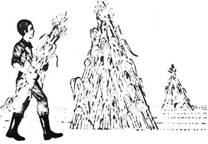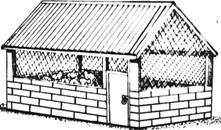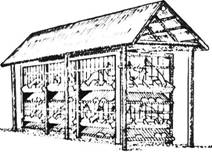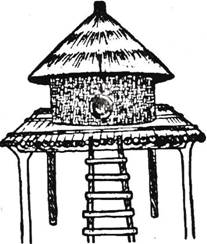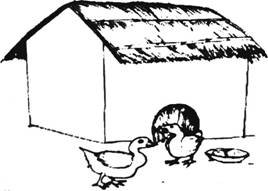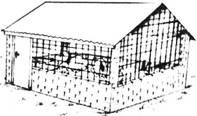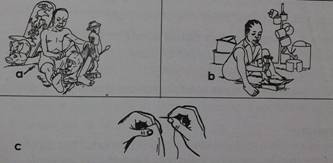CLICK ANY OF THE UNITS BELOW TO START YOUR STUDIES
UNIT 1 THE MEANING OF AGRICULTURE
UNIT 2 BRANCHES OF AGRICULTURE
UNIT 3 IMPORTANCE OF AGRICULTURE
UNIT 5 FARM BUSINESS ACTIVITIES
UNIT 6 THE MAJOR ELEMENTS OF THE AGRICULTURAL ENVIRONMENT
UNIT 7 HARMFUL EFFECTS OF THE MAJOR ELEMENTS OF THE AGRICULTURAL ENVIRONMENT
UNIT 8 MANAGEMENT OF THE MAJOR ELEMENTS OF THE AGRICULTURAL ENVIRONMENT
UNIT 10 SAFE WAYS OF USING FARM TOOLS
UNIT 11 MAINTENANCE OF FARM TOOLS
UNIT 14 CROP HUSBANDRY PRACTICES
UNIT 15 LAND PREPARATION AND PLANTING IN MAIZE CROP
UNIT 16 WEEDING AND FERTILIZER APPLICATION IN MAIZE CROP
UNIT 17 PEST AND DISEASE CONTROL IN MAIZE CROP
UNIT 18 HARVESTING AND STORAGE OF MAIZE CROP
UNIT 19 FARM ANIMALS RAISED IN MALAWI
UNIT 20 IMPORTANCE OF FARM ANIMALS
UNIT 21 ANIMAL HUSBANDRY PRACTICES
UNIT 22 HOUSING AND FEEDING FARM ANIMALS
UNIT 23 DISEASE AND PARASITE CONTROL AND BREEDING OF FARM ANIMALS
UNIT 25 IMPORTANCE OF TREES GROWN IN MALAWI
UNIT 1 MEANING OF AGRICULTURE
MEANING OF THE TERM ‘AGRICULTURE’
Agriculture is the practice of growing crops and rearing animals on or farm for people's use.
Substitution table for defining the term ‘agriculture’
Agriculture is |
the task the job
the art
the study |
of growing crops and rearing animals |
on land on farm |
for people’s use.
for people’s enjoyment. for profit. |
Some farming activities
- Rearing poultry
- Fish farming
- Rearing rabbits
- Growing tobacco
- Growing flowers
- Vegetable farming
- Fruit farming
- Rearing goats
- Rearing sheep
- Rearing cattle
- Raising pigs
- Growing trees
UNIT 2 BRANCHES OF AGRICULTURE
BRANCHES OF AGRICULTURE
- crop production
- animal production
SUB-BRANCHES OF AGRICULTURE UNDER CROP PRODUCTION
- agronomy
- arboriculture
- Silviculture
- Agroforestry
- Horticulture
- Pomoculture
- Floriculture
- Olericulture
SUB-BRANCHES OF AGRICULTURE UNDER ANIMAL PRODUCTION
- Cattle farming
- Goat farming
- Pig farming
- Sheep farming
- Poultry
- Fish farming
- Rabbitry
- Apiculture
SUB-BRANCHES OF AGRICULTURE UNDER CROP PRODUCTION, THEIR MEANINGS AND EXAMPLES
SUB-BRANCH |
MEANING |
EXAMPLES |
Agronomy |
Production of field crops |
Maize, cassava, tobacco, cotton |
Arboriculture |
Production of ornamental plants |
Hibiscus, rose flowers |
Silviculture |
Production of trees |
Jacaranda, bloodwood (mlombwa), |
Agroforestry |
Growing of field crops and trees |
Maize and msangu, sorghum and leucaena, |
Horticulture |
Production of fruits, vegetables and |
Mangoes, mustard, flamboyant |
Pomoculture |
Production of fruits only |
Oranges, tamarind (bwemba), granadillas |
Floriculture |
Production of flowers only |
Periwinkle, marigold, night queen |
Olericulture |
Production of vegetables |
African spinach (bonongwe), nkhwani, |
SUB-BRANCHES OF AGRICULTURE UNDER ANIMAL PRODUCTION, THEIR MEANINGS AND EXAMPLES
SUB-BRANCH |
MEANING |
EXAMPLES |
Cattle farming |
Keeping of cattle |
Zebu, Brahman |
Goat farming |
Keeping of goats |
Malawian goat, Boer goat |
Pig farming |
Keeping of pigs |
Landrace, large white |
Sheep farming |
Keeping of sheep |
Dorper |
Poultry |
Keeping of domesticated birds |
Chickens, ducks, guinea fowl |
Fish farming |
Raising of fish in ponds |
Makumba, chambo |
Rabbitry |
Keeping of rabbits |
California, Chinchilla |
Apiculture |
Keeping of bees |
Honey bees |
Some farm animals
 |
 |
 |
| a goat | a turkey | a sheep |
 |
||
| a rabbit | ||
UNIT 3 IMPORTANCE OF AGRICULTURE
IMPORTANCE OF AGRICULTURE AT INDIVIDUAL LEVEL
- Source of food
- Source of income
- Source of employment
IMPORTANCE OF AGRICULTURE AT FAMILY LEVEL
- Source of food
- Source of income
- Source of employment
IMPORTANCE OF AGRICULTURE AT NATIONAL LEVEL
- Source of food
- Source of income
- Source of foreign exchange
- Source of raw materials
UNIT 4 FARMING METHODS
TYPES OF FARMING METHODS
- Subsistence farming
- Commercial farming
Subsistence farming
This is the growing of crops and raising of animals mainly for food.
Crops grown by subsistence farmers
- Maize
- Millet
- Sorghum
- Pigeon peas
- Rice
- Cassava
- Pumpkins
Animals raised mainly for food
- Ducks
- Pigeons
- Rabbits
- Chickens
- Guinea fowls
Main characteristics of subsistence farming
- Production of food to feed the family
- Production of crops and animals which are sold at low price
- Production of crops on a very small area, or keeping of very few animals
- Dependency mainly on rainfall
- Low levels of inputs
- Uses mainly family labour and hand tools
- There is rarely a surplus for sale
Commercial farming
This is the growing of crops and raising of animals mainly for sale.
Animals raised for sale
- Cattle
- Fish
- Bees
- Pigs
Crops grown mainly for sale
- Cotton
- Coffee
- Tea
- Tobacco
Main characteristics of commercial farming
- Production is mainly for cash
- Crops and animals produced are sold for profit
- Crops are grown on a large area and many animals are raised
- It involves high levels of inputs
MEANING OF THE TERM BUSINESS
A business is any activity that people do with the aim of making profits.
Farming as a business
Agricultural activities which can be done with the aim of making profits include keeping of bees, chickens, cattle, and goats for sale, and growing of flowers, vegetables, fruits and maize for sale.
Farmers can also sell manure and grass for feeding animals to increase profits from agricultural activities.
Aims of agriculture as a business
- Increasing yield per unit area
- Reducing cost per unit area
- Maximizing profits
UNIT 5 FARM BUSINESS ACTIVITIES
FARM BUSINESS ACTIVITIES
- Decision making
- Farm financing
- Record keeping
- Marketing
Decision making
This involves making decisions.
The farmer has to decide on the following:
- What to produce
- How to produce
- How much to produce
- Where to buy or sell
- When to produce, buy or sell
Farm financing
This involves finding money for running farm business.
Sources of the money can be personal savings or borrowing from money lending organisations.
Record keeping
This involves the keeping of the records of all activities at the farm.
These written records help the farmer to know whether the business is making profits or not.
Marketing
This involves selling the right products to the right customers at the right time, place and price.
UNIT 6 MAJOR ELEMENTS OF THE AGRICULTURAL ENVIRONMENT
THE MAJOR ELEMENTS OF THE AGRICULTURAL ENVIRONMENT
Agricultural production involves production of crops and raising of farm animals.
The production of these depends on the surroundings which include living things, non-living things and conditions such as weather.
Agricultural environment means everything around crop plants and farm animals.
THE MAJOR ELEMENTS OF THE AGRICULTURAL ENVIRONMENT
- Soil
- Water
- Plants
- Animals
- Sunlight
- Wind
IMPORTANCE OF THE AGRICULTURAL ENVIRONMENT
Importance of soil
- Soil holds crop plants
- Soil is a source of nutrients, water and air for crop plants
- Soil is used for making animal houses and storage rooms for farm produce
Importance of water
- Water is used by crop plants to make their own food
- Water dissolves nutrients in the soil to be used by crop plants
- Water cools the crop plants and farm animals
- Water is used for drinking by farm animals
- Water cools the soil where plants grow
Importance of plants
- Plants conserve water for crops and farm animals
- Plants protect the soil from losing nutrients
- Plants rot and form manure for the growth of other plants
- Plants are a source of feed to farm animals
- Plants are used for making animal houses
Importance of animals
- Animals provide manure for plant growth
- Animals control pests in crop fields by eating them
- Animals are used for making holes in the soil, allowing air to go in
- Animals are a source of food for other animals
Importance of sunlight
- Sunlight is used by crop plants to make their food
- Sunlight makes farm animals to produce eggs
- Sunlight dries farm produce
Importance of wind
- Wind is used for cooling plants and animals
- Wind is used for drying agricultural products
- Wind is used for removing light useless matter in farm produce
- Wind is used for pollination
UNIT 7 HARMFUL EFFECTS OF THE MAJOR ELEMENTS OF THE AGRICULTURAL ENVIRONMENT
The major elements of the agricultural environment may provide favourable conditions for agricultural production.
However these same elements may be harmful to agricultural production.
UNFAVOURABLE CONDITIONS OF SOME OF THE HARMFUL EFFECTS OF THE MAJOR ELEMENTS OF THE AGRICULTURAL ENVIRONMENT
Elements of agricultural environment |
Unfavourable conditions |
Harmful effects on crops and farm animals |
Soil |
|
|
Water |
|
|
Plants |
|
|
Animals |
|
|
Sunlight |
|
|
Wind |
|
|
UNIT 8 MANAGEMENT OF THE MAJOR ELEMENTS OF THE AGRICULTURAL ENVIRONMENT
The major elements of the agricultural environment can be managed in order to minimise their harmful effects on agricultural production.
Management of the major elements of the agricultural environment
Element of the agricultural environment |
Ways of managing them |
Soil |
|
Water |
|
Plants |
|
Animals |
|
Sunlight |
|
Wind |
|
UNIT 9 COMMON FARM TOOLS
Common farm tools are simple machines used by farmers when carrying out different operations on a farm.
Some common farm tools and their uses
Tools |
|
Uses |
A hoe |
|
|
An axe |
|
|
A slasher |
|
|
A sickle |
|
|
A watering can |
|
|
A rake |
|
|
A hand trowel |
|
|
A hand fork |
|
|
A panga knife |
|
|
UNIT 10 SAFE WAYS OF USING FARM TOOLS
There are correct ways to be followed when handling and using farm tools to ensure safety.
Handling
- Ensure that blades point away from the body
- Ensure that blades are properly fixed to their handles
- All tools with sharp blades should be hanged on the wall to avoid injury
Use
- Ensure that tools are firmly fixed to their handles
- Be sure that farm tools are in good conditions
- Be sure that the tools are used for their intended purpose
- Make sure that there is enough space between people working
UNIT 11 MAINTENANCE OF FARM TOOLS
Maintaining farm tools means putting the farm tools in good conditions for use.
MAINTENANCE OF SOME FARM TOOLS
Tool |
Ways of maintaining farm tools |
Hoe, axe, slasher, panga, sickle |
|
Rake, hand fork, hand trowel |
|
Watering can |
|
UNIT 12 CROPS GROWN IN MALAWI
Various crops are grown in Malawi. Such crops include:
- Maize
- Tobacco
- Groundnuts
- Millet
- Peas
- Soya beans
- Tomatoes
- Cassava
- Rice
- Cabbage
- Cotton
- Sugarcane
- Sorghum
- Sunflower
- Beans
- Mangoes
- Oranges
- Pineapples
- Pawpaws
- Irish Potatoes
- Sweet potatoes
- Tea
- Coffee
- Pumpkins
- Melons
- Cucumbers
- Bananas
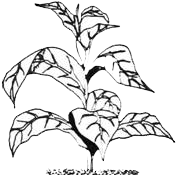 |
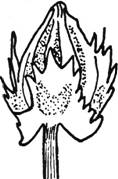 |
 |
 |
|
| tobacco | cotton | sunflower | Banana | |
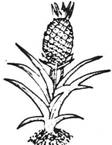 |
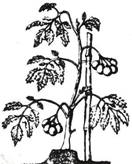 |
|||
| pineapples | tomatoes | |||
FOOD AND CASH CROPS GROWN IN MALAWI
Food crops |
Cash crops |
Maize |
Tobacco |
Millet |
Tea |
Sorghum |
Coffee |
Cassava |
Sunflower |
Rice |
Cotton |
Beans |
Sugarcane |
Peas |
Water melon |
Potatoes |
Tangerines |
Tomato |
Oranges |
Cabbage |
|
Pawpaws |
|
Mangoes |
|
Cucumbers |
|
Groundnuts |
|
CROPS GROWN IN SPECIFIC AREAS IN MALAWI
Crop |
Growing areas |
Maize |
All districts in Malawi |
Tobacco |
Kasungu, Mchinji, Lilongwe, Dowa, Ntchisi, Rumphi, Machinga, Mzimba, and |
Cotton |
Karonga, Salima, Nsanje, Chikwawa, Bwanje Valley, Mwanza, and Mangochi |
Groundnuts |
Almost all districts in Malawi |
Millet and sorghum |
Chikwawa, Nsanje, Karonga, Mzimba and Chitipa |
Sugarcane |
Chikwawa and Nkhotakota |
Beans |
Dedza, Ntcheu and Nkhotakota |
Tomatoes |
Dedza, Ntcheu and Salima |
Cassava |
Nkhotakota, Karonga, Salima, Zomba, Dedza, Kasungu and Rumphi |
Cabbage |
Ntcheu, Dedza, Thyolo and Mzimba |
Sunflower |
Chitipa, Mzimba, Kasungu, Lilongwe, Mchinji, Phalombe and Balaka |
Sweet potatoes |
Almost all districts in Malawi |
Irish potatoes |
Ntcheu, Dedza, Ntchisi, Chitipa and Rumphi |
Bananas |
Thyolo, Mulanje, Nkhatabay, Karonga and Chitipa |
Oranges |
Mwanza, Thyolo and Neno |
Pineapples |
Mulanje, Thyolo, Nkhatabay, Karonga and Rumphi |
Mangoes |
Almost in all districts in Malawi |
Pawpaws |
Almost in all districts in Malawi |
UNIT 13 INPORTANCE OF CROPS
Crops are important in many ways. These importance are:
- Sources of food
- Sources of animal feed
- Sources of employment
- Sources of foreign exchange
- Sources of raw materials
- Sources of income
RAW MATERIALS AND THEIR PRODUCTS
Raw materials |
Industry |
Products |
Sugarcane |
Sugar industry |
Sugar, molasses |
Soya beans |
Hatchery and food industry |
Poultry feed |
Groundnuts |
Oil processing industry |
Cooking oil and margarine |
Tobacco |
Tobacco processing industry |
Cigarettes |
Cotton |
Clothing industry |
Clothes |
Maize |
Milling company |
Maize flour, breakfast cereal |
Millet |
Breweries |
Opaque beer, breakfast cereal |
UNIT 14 CROP HUSBANDRY PRACTICES
MEANING OF ‘CROP HUSBANDRY PRACTICES’
Crop husbandry practices are the activities that are carried out when growing crops.
CROP HUSBANDRY PRACTICES AND THEIR RELATED ACTIVITIES
Crop husbandry practice |
Related activity |
Land preparation |
|
Planting |
|
Weeding |
|
Fertilizer application |
|
Disease and pest control |
|
Harvesting |
|
Storage |
|
These crop husbandry practices have to be carried out properly to obtain high crop yield.
UNIT 15 LAND PREPARATION AND PLANTING IN MAIZE
LAND PREPARATION ACTIVITIES
Activity |
Description of the activity |
Site selection |
Select fertile land |
Marking ridge |
Mark ridges at 75cm apart for sasakawa, 90cm apart for other methods of |
Land clearing |
Cover lightly organic matter along the marked lines using a hoe |
Ridging |
Make ridges 20cm high by covering the organic matter properly |
Marking planting |
Mark planting stations at 25cm apart for sasakawa or 75cm apart for planting |
Manure |
Apply a double handful of well decayed manure per planting station |
Land preparation
Land for maize should be prepared early because:
- It is easier to work when the soil is still moist
- It gives enough time for buried plant residues to rot
- It leads to early planting
Maize varieties
There are several varieties of maize that have been recommended in Malawi.
Seed selection
The following characteristics should be considered when selecting seed for planting:
- Large in size
- Not broken (whole)
- Free from disease and pest attack
- Not shrivelled
Plant spacing
The spacing between maize plants varies depending on the variety. Tall varieties need wider spacing.
Short varieties need closer spacing.
Recommended spacing and number of plants per station
Planting spacing |
Number of seeds per station |
90cm |
3 |
75cm |
3 |
60cm |
2 |
50cm |
2 |
40cm |
1 |
30cm |
1 |
25cm |
1 |
Planting maize
Maize planting involves:
- Marking out planting stations at a recommended spacing
- Planting the correct number of seeds per station
- Covering the planting hole (burying seed) at 7 to 10 centimetres deep
Planting should be done early because:
- the crop makes full use of soil nutrients before they are leached
- the crop uses most of the rains in the growing season
- the crop matures before some pests and diseases become serious
UNIT 16 WEEDING AND FERTILIZER APPLICATION IN MAIZE CROP
WEEDING
Weeding is the removal of unwanted plants in the garden
IMPORTANCE OF WEEDING
- weeding helps to reduce competition between crops and weeds for food, sunlight, air, water and space
- weeding helps to reduce pests and diseases in the garden
COMMON WEEDS IN MALAWI
- black jack (chisoso)
- Bengal commelina (khovani) also known as wandering Jew
- Amaranthus (bonongwe)
- Witch weed (kaufiti)
- Msonthi
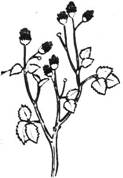 |
 |
 |
 |
|
| black jack | witchweed | stargrass | amaranthus |
Weeds should be removed as soon as they appear for the following reasons:
- To ensure that they use as little food as possible
- To ensure that their removal does not damage roots of the growing crop plants
WEEDING METHODS
| Methods | Description |
Uprooting |
Removing weeds by hand |
Light hoeing |
Removing weeds using a hoe |
Banking |
Burying weeds along the edge |
Applying herbicides |
Spraying chemicals that kill weeds |
FERTILIZER APPLICATION
Fertilizer or manure should be applied to provide the required nutrients for maize.
Fertilizer application
| Timing | Fertilizer |
Rates per station (at 25cm apart and 1 seed per station) |
At planting |
23:21:0 +4s |
1 coke bottle top without a liner inside |
4 weeks after |
Urea |
1 coke bottle top with a liner inside |
Emergence |
CAN |
1 coke bottle top without a liner inside |
UNIT 17 PEST AND DISEASE CONTROL IN MAIZE CROP
PESTS
Pests are living organisms which attack crop plants.
SOME MAIZE PESTS
Pest |
Damage caused |
Control |
Stalk borer |
Makes holes on leaves Burrows into the stem of a |
Apply dipterex (trichlorfon) into the funnel of maize plant |
Maize weevil |
Drills holes into the grain |
Apply a suitable antipest dust |
Army worm |
Eat young plants |
Trap-dig to the ground trenches around a garden |
Red locust |
Eats leaves from the margin |
Hand pick |
Large short honed |
Eats leaves |
Spray carbaryl or sumithion or sumicidin |
Rodents (rats) |
Eat grain |
Use rat guards on nkhokwes or traps Place rat poison in the storage structure |
Some pests of maize
 |
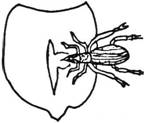 |
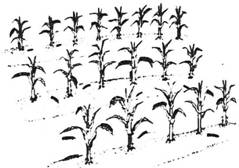 |
||
| stalk borer | maize weevil | army worms | ||
 |
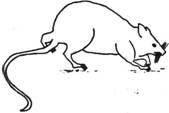 |
|||
| red locusts | a rat |
Maize diseases
COMMON MAIZE DISEASES AND THEIR CONTROL
Disease |
Symptoms |
Control |
Head smut |
Black powdery substance covering tassels and |
Uprooting or burning infected parts |
Maize streak |
Loss of green colour along parallel veins on leaves |
Planting early |
Leaf bright |
Long spots on leaves |
Growing resistant varieties |


The head smut disease
UNIT 18 HARVESTING AND STORAGE OF MAIZE
MAIZE HARVESTING
Harvesting should be done as soon as maize is fully dry. At this stage, the cobs droop (bend downwards).
Maize can be harvested by:
- Picking the cobs directly from plants still standing in the garden
- Picking cobs from stalks of maize in a stook (a standing heap of cut maize stalks)
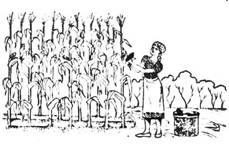
Methods of harvesting maize
stooking
direct stripping
Importance of stooking
- It facilitates further (complete) drying of the crop
- It simplifies harvesting
- It enables the farmer to plough the cleared area while the soil is still moist
Maize storage
Maize should be stored in dry and ventilated structures. This controls diseases and pests which cause damage.
Maize can be stored in granaries (cribs or nkhokwes) and sacks. Granaries should be made rat-proof by using rat guards.
They should be properly thatched to prevent leaking.
Some ways of storing maize
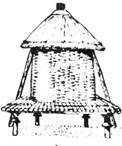
a maize granary
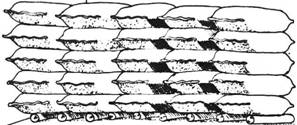
maize sacks
UNIT 19 FARM ANIMALS RAISED IN MALAWI
In Malawi, there are several types of animals, but not all of them are kept as farm animals. COMMON FARM ANIMALS
- Cattle
- Goats
- Sheep
- Rabbits
- Chickens
- Ducks
- Fish
- Bees
- Turkeys
- Pigeons
- Guinea fowls
- Pigs
Farm animals differ in many characteristics These characteristics include:
- Body size
- Number of legs
- Shape
- Size of eyes
- Colour of fur or feathers
- Skin cover
- Presence or absence of scales
- Beards
- Fins
- Horns
Some farm animals

a pig

fish

duck

horse

sheep

pigeon
UNIT 20 IMPORTANCE OF FARM ANIMALS
REASONS FOR KEEPING FARM ANIMALS
- Source of food
- Source of manure
- Source of income
- Source of raw materials
- Source of employment
- Source of power
- Source of employment
- Cultural reasons
- Social reasons (prestige)
UNIT 21 ANIMAL HUSBANDRY PRACTICES
Animal husbandry practices are the activities of caring for farm animals. Animal husbandry practices are done to obtain high production.
FOUR MAIN TYPES OF ANIMAL HUSBANDRY PRACTICES
- Housing
- Feeding
- Breeding
- Disease and pest control
If these practices are not properly carried out, production may be low.
Some animal husbandry practices
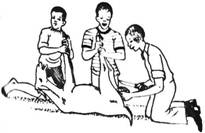
castrating a goat
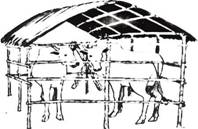
cattle in a khola
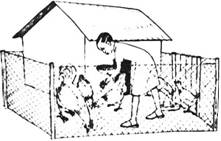
feeding chickens
UNIT 22 HOUSING AND FEEDING FARM ANIMALS
TYPES OF FARM ANIMAL HOUSES
There are different animal houses depending on the type of animals kept. A good animal house should serve its purpose.
Cattle houses
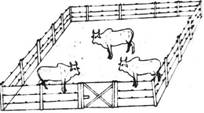
a barbed wire cattle house
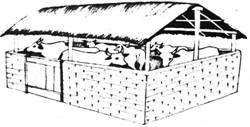
a brick cattle house
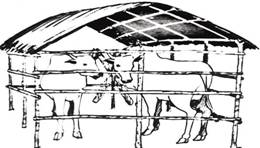
a pole and thatch cattle house
Goat and pig houses
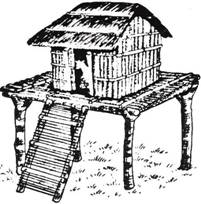 |
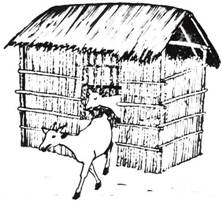 |
|||
| a raised goat house | an unraised goat house | |||
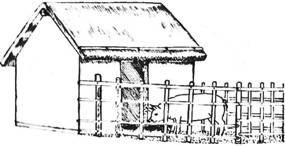 |
||||
| A pig house | ||||
Chicken houses |
||||
CHARACTERISTICS OF ANIMAL HOUSES
- Have strong walls
- Be roomy, well-lit and well-ventilated
- Be well-drained and easy to clean
- Be well-thatched
- Be of a solid floor
- Be warm in winter and cool in summer
IMPORTANCE OF HOUSING FARM ANIMALS PROPERLY
- Animals are protected from diseases, parasites and predators
- Animals are protected from bad weather like wind, rains and direct sunshine
- It provides easy control of animals
- It is easy to collect products like eggs, milk and manure
IMPORTANCE OF FEEDING FARM ANIMALS PROPERLY
- Maintenance of life such as walking and breathing
- Production of meat, milk, eggs and power
- Protecting the animals from diseases
UNIT 23 DISEASE AND PARASITE CONTROL AND BREEDING OF FARM ANIMALS
EFFECTS OF DISEASES ON ANIMAL PRODUCTION
- Loss of production
- Loss of animals
- Transmission of diseases to human beings
EFFECTS OF PARASITES ON ANIMAL PRODUCTION
- The attacked part becomes unfit for people to eat
- Loss of income to the farmer
- Transmission of diseases to the host animal
- Sucking food nutrients from the host animal
- Causing discomfort to animals
METHODS OF CONTROLLING DISEASES
- Quarantine
- Disinfection
- Use of resistant breeds
- Control of vectors
- Vaccination
METHODS OF CONTROLLING PARASITES
- Spraying chemicals to animals and animal houses
- Killing the parasites by hand
- Dippin

- drenching a cow
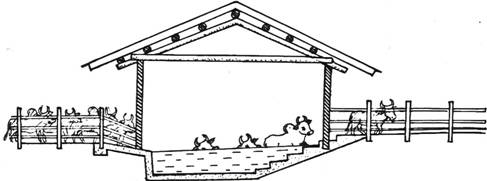
cattle dipping
WHAT BREEDING FARM ANIMALS INVOLVES
Breeding means increasing the number of animals or improving the characteristics of the animal. This generally involves selecting or choosing animals with good characteristics to be parents.
Some of the characteristics are large size, high milk production, those that fight diseases and parasites properly and quick growth.
CHARACTERISTICS OF LOCAL BREEDS OF FARM ANIMALS
- Withstand conditions like poor feeding and high temperatures
- Resist disease and parasite attack
- Are able to walk long distances in search of food and water without getting very tired and losing condition
- Are small in size
- Give low production
- Grow slowly
CHARACTERISTICS OF IMPROVED BREEDS
- High yield production
- Grow big in size
- Grow fast
- Have low resistance to diseases and parasites
- Do not do well under poor feeding and high temperatures
- Get tired easily
IMPORTANCE OF IMPROVING THE LOCAL BREEDS
- The improved local breed will produce more than the local breed
- The improved local breed will be larger in size than the local breed
- The improved local breed will grow faster than the local breed
UNIT 24 TREES GROWN IN MALAWI
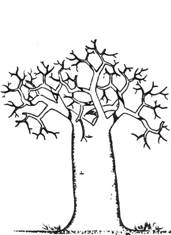
The baobab
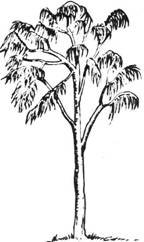
bluegum
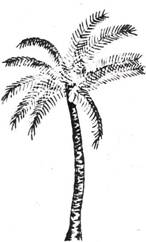
palm tree
NAMES OF SOME TREES GROWN IN MALAWI
- Msangu
- Gmelina
- Cinderella
- Bluegum
CLASSIFICATION OF TREES
Trees are classified into two main groups.
These are:
- Indigenous trees
- Exotic trees
Indigenous trees
Indigenous trees are trees that originally grow in Malawi.
These include msangu, the baobab, msambamfumu, thundu, mkuyu, bwemba, msuku, mtondo, muwanga, chitimbe, tsanya, mlombwa and mombo.
Exotic trees
Exotic trees are trees that are brought into Malawi from other distant countries.
These include bluegum, gmelina, pine, neem, India, jacaranda, Cinderella and leucaena.
CHARACTERISTICS OF INDIGENOUS TREES
- They are hard and tough
- They withstand drought
- They resist disease and pest attack
- They grow well with little care
- They grow slowly and take a long time to mature
CHARACTERISTICS OF EXOTIC TREES
- They grow fast
- They are soft
- They cannot withstand drought
- They are easily attacked by diseases and pests
- They demand more care
WAYS OF IMPROVING INDIGENOUS TREES
- By raising seedlings properly
- By applying manure
- By transplanting the seedlings at the appropriate spacing
- By weeding
- By pruning them
- By constructing firebreaks around them
UNIT 25 IMPORTANCE OF TREES GROWN IN MALAWI
IMPORTANCE OF TREES
- Source of medicine
- Source of furniture
- Source of firewood
- Source of food
- Improvement of soil fertility
- Provision of shelter
- Source of raw materials
- Source of income
- Source of employment
- Reduction of soil erosion
- Conservation of water
- Supply of oxygen
- Some trees provide wind breaks
UNIT 26 TYPES OF FORESTS
MEANING OF THE TERM ‘FOREST’
A forest is a large area of land covered by trees and grass.
TYPES OF FORESTS
There are two types of forests.
These are:
- Natural forests
- Planted forests
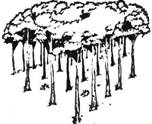
planted forest
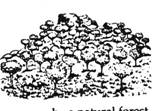
natural forest
Natural forests
Natural forest is a forest made up of trees growing on their own.
Natural forests in Malawi include Karwe in Nkhatabay, Chimaliro in Kasungu, Perekezi in Mzimba, Khurubvi in Nsanje, Ntchisi and Michiru in Blantyre.
Planted forests
Planted forest is a forest made up of planted trees. They can be either indigenous or exotic trees.
Planted forests in Malawi include Chikangawa in Mzimba, Chongoni in Dedza and Zomba mountains.
DIFFERENCES BETWEEN NATURAL AND PLANTED FORESTS
Planted |
Natural |
Usually trees of one type are grown |
Usually different types of trees grow |
Trees are properly spaced and forming a pattern |
Trees are scattered without a pattern |
Trees grow uniformly |
Trees grow without uniformity |
Trees are grown for a purpose |
They grow on their own for different |
Trees are cared for by, for example, watering and |
Trees are not cared for |
UNIT 2 THE CALL OF THE TWELVE APOSTLES
UNIT 4 HUMAN RIGHTS AND DEMOCRACY
UNIT 8 THE NATURAL ENVIRONMENT
UNIT 9 THE DEPARTURE OF THE HEBREWS FROM EGYPT TO CANAAN
UNIT 11 DRUG AND SUBSTANCE ABUSE
JACOB’S FAMILY (Genesis 35:23-26; 37:1-36)
Jacob had thirteen children, one daughter and twelve sons from four different mothers. One of the sons was Joseph. Jacob loved Joseph more than the rest of the children.
This caused his brothers to hate him.
In addition, Joseph had dreams which angered his brothers the more.
This anger and hatred for Joseph led his brothers to sell him to the Ishmaelites. The Ishmaelites sold him to Egypt where he rose to the position of prime minister. Famine in Canaan forced Jacob’s family to move to Egypt.
After staying for many years in Egypt, the Hebrews were made slaves.
MEMBERS OF JACOB’S FAMILY
Jacob’s wives:
- Rachel
- Leah
Jacob’s concubines:
- Bilhah
- Zilpah
Jacob’s daughter:
- Dinah (Dinah’s mother was Leah)
Jacob’s sons
- Reuben
- Simeon
- Levi
- Judah
- Issachar
- Zebulun
- Joseph
- Benjamin
- Dan
- Naphtali
- Gad
- Asher
JACOB’S SONS AND THEIR MOTHERS
Sons of Leah
- Reuben
- Simeon
- Levi
- Judah
- Issachar
- Zebulun
Sons of Rachel
- Joseph
- Benjamin
The sons of Rachel’s servant Bilhah
- Dan
- Naphtali
The sons of Leah’s servant Zilpah
- Gad
- Asher
JOSEPH IN CANAAN AND EGYPT (Genesis 35:23-26; 37:1-36; 40:1-22; 41:1-57)
Isaac lived in Canaan and had two sons, Esau and Jacob.
The family of Isaac used to keep livestock as their main occupation.
Rebecca, Isaac’s wife, planned that the heirship should go to Jacob against patriarchal tradition. Because of this planned deceit, there was rivalry between Jacob and Esau.
Jacob fled to Mesopotamia where he lived with his uncle Laban. Laban had two daughters, Leah and Rachel.
Jacob loved the younger one, Rachel.
The custom required that the older daughter marries first.
However, Laban disguised Leah and gave her to Jacob instead of Rachel after seven years of work as dowry (lobola).
This became possible because marriage was always consummated in the night.
In the morning, Jacob discovered that Laban had given him Leah instead of Rachel. He was angry.
Laban promised to give him Rachel after serving another seven years. Because of his love for Rachel, Jacob agreed.
UNIT 2 THE CALL OF THE TWELVE APOSTLES
Disciples are the followers of Jesus.
Apostles are the messengers of Jesus.
THE CALL OF THE DISCIPLES (Luke 5:1-11; Matthew 4:18-22; Mark 1:16-20)
After baptism, the Holy Spirit led Jesus to the desert. Subsequently, Jesus began His ministry in Galilee.
The news about His ministry spread throughout Galilee.
Many people followed Him because of the teaching, miracles and acceptance of the outcast. Some of the disciples were Simon Peter, Andrew, James and John.
THE CHOICE OF THE APOSTLES (Mark 3:13-19; Mark 10:1-4; Luke 6:12-13)
Jesus had disciples who followed him.
From these disciples, Jesus chose twelve men whom he named apostles. He gave them the power to preach, heal and drive out demons.
The names of the twelve selected men as apostles were:
- Simon (Jesus named him Peter)
- James (son of Zebedee)
- John (son of Zebedee)
- Andrew
- Philip
- Bartholomew
- Matthew
- Thomas
- James (son of Alphaeus)
- Thaddaeus
- Simon (the Zealot)
- Judas Iscariot (he betrayed Jesus)
To the sons of Zebedee, Jesus gave them the name Boanerges, which means “sons of thunder”.
BELIEVERS TODAY (Matthew 4:12; Luke 4:14-15; 5:1-5; Mark 2:12-13)
Every Christian today is supposed to be a follower and believer of Jesus Christ.
In the past, followers of Jesus Christ were told to abandon their activities and sell their wealth in order to dedicate their lives to God.
DUTIES OF JESUS’ FOLLOWERS
- Preaching the Word of God
- Praying for themselves and others
- Helping the needy
UNIT 3 THE LOVE OF JESUS
TEACHINGS ABOUT LOVE (Matthew 15:22-28; Luke 7:1-10; 10:25-30; Mark 7:24-30; Mathew 25:31-40)
Love is the foundation of unity, peace and justice among people. Christians are taught to love one another.
The commandment on loving one another as one loves oneself concerns people’s relationships. Jesus, love therefore is more than just a word or feeling.
THE IMPORTANCE OF LOVE
- Love brings about a sense of belonging
- Love makes people to feel pity for those in troubles and help them
- Love makes people to be tolerant
- Loves makes people to love one another
- Love makes people to trust one another
- Love makes people to protect human rights
- Love makes people to promote justice
THE PARABLE OF THE GOOD SAMARITAN (Luke 10:25-30)
A teacher of the law came up and tried to trap Jesus. He asked, “What must I do to receive eternal life?”
Jesus answered him, “What do the scriptures say? How do you interpret them?”
The man answered, “Love the Lord your God with all your heart, with all your soul, with all your mind and love your neighbour as yourself”.
“You are right,” Jesus replied, do this and you will live. But the teacher wanted to justify himself, so he asked Jesus, “Who is my neighbour?”
Jesus answered, “There was a man who was going down from Jerusalem to Jericho. On the way, robbers attacked him, stripped him and beat him up, leaving him half dead. It so happened that a priest was travelling on the same road, but when he saw the man, he walked by, on the other side. So too the Levite, when he came to the place and saw him, he just walked by on the other side.
But a Samaritan who was travelling on the same road came upon the man, and when he saw him, his heart was filled with pity. He went over to him, poured oil and wine on his wounds and bandaged them. Then he put the man on his own animal and took him to an inn where they cared for him.”
UNIT 4 HUMAN RIGHTS AND DEMOCRACY
THE RIGHTS OF CHILDREN (Luke 2:42-49; 18:15-17; Genesis 2:7)
A right is an entitlement.
When a person is entitled to things, it means that he or she can demand that thing. A right is different from a privilege.
If a person has a privilege to have something, he or she may have it, but can be withdrawn at any time the person giving it decides to do so.
On the other hand, a right as an entitlement cannot be withdrawn anyhow.
RIGHTS OF CHILDREN
- Right to education
- Right to be cared for by parents
- Right to life
RIGHTS AND RESPONSIBILITIES OF FAMILY MEMBERS
A family is composed of parents or guardians and children. Each member in the family has rights.
In addition, each member has responsibilities to carry out within the family. Similarly, within the Christian families, there are rights and responsibilities.
However, children belong to one of the vulnerable groups in the society.
In most of the policy-making bodies, whether in a family or society, children are not consulted in the decision-making processes.
As a result, laws and decisions made by adults do not take into consideration the needs, interests and aspiration of children.
RESPONSIBILITIES OF CHILDREN AT HOME
- Respecting parents and siblings
- Doing household chores like cleaning plates, sweeping the surroundings and mopping
RESPONSIBILITIES OF CHILDREN AT CHURCH
- Respecting the elders and others
- Keeping quiet during sermons
- Keeping the surrounding clean
RESPONSIBILITIES OF CHILDREN AT SCHOOL
- Respecting teachers and other learners
- Keeping the surrounding clean
- Writing exercises given
- Studying notes
- Writing tests and examinations
CHRISTIAN RIGHTS AND RESPONSIBILITIES
The Bible has stories about the roles and responsibilities of family members.
In Genesis 25:27-34, for example, each member in Isaac’s family had some responsibilities to assist in the welfare of other people.
UNIT 5 THE CALL OF MOSES
THE BIRTRH OF MOSES (Exodus 1:15-18; 2:1-10)
Moses was an Israelite but born in Egypt to a man of the tribe of Levi who married a Levite woman. The name of the mother of Moses was Jacobed.
When he was born, his mother saw that Moses was a fine child and she hid her for three months.
However when she could hide him no longer, Moses’ mother got a papyrus basket for him and coated it with tar and pitch.
Then she placed the child in it and put it among the reeds along the bank of the Nile.
The mother hid Moses along the river bank because the mother feared that Moses could be killed by the Egyptians.
One day, Pharaoh’s daughter went down to the Nile to bathe. She saw the basket among the reeds. When she opened it, she the baby who was crying and felt pity for him.
The Pharaoh’s daughter took Moses as her own Hebrew child and stayed with him in Pharaoh’s palace.
THE FLIGHT OF MOSES FROM EGYPT TO MIDIAN (Exodus 2:11-24)
When Moses had grown up, he went out to where his own people were and watched them at their hard labour.
He saw an Egyptian beating a Hebrew, one of his own people. Looking this this way and that way and seeing no one, he killed the Egyptian and hid him in the sand.
The next day he went out and saw two Hebrews fighting. He asked the one in the wrong, “Why are you hitting your fellow Hebrew?”
The man said, “Who made you ruler and judge over us? Are you thinking of killing me as you killed the Egyptians?”
Then Moses was afraid and thought, “What I did must have become known.”
When Pharaoh heard of this, he tried to kill Moses, but Moses fled from Pharaoh and went to live in Midian.
GOD’S CALL OF MOSES (Exodus 3:1-21; 7:1-11)
Now Moses was tending the flock of Jethro his father in-law, the priest of Midian, and he led the flock to the far side of the wilderness and came to Horeb, the mountain of God.
There the angel of the Lord appeared to him in flames of fire from with a bush. Moses saw that though the bush was on fire it did not burn up.
Then Moses went over to see that strange sight.
When the Lord saw that he had gone over to look, God called to him from within the bush.
Moses wanted to go closer but God told him to do so. And God told him to take off his sandals (shoes) because the place Moses was standing was a holy ground.
It is there when God told him (called him through the burning bush) to go back to Egypt to release the Hebrews from slavery. Moses took his brother Aaron to go to Egypt with him.
UNIT 6 HEALING MIRACLES
THE MIRACLES THAT JESUS PERFORMED UPON REQUEST (Luke 5:17-26; 7:1-10; 8:40-42; 49-56;
17:11-19)
The Bible gives various examples of healing miracles by Jesus.
One factor that needs emphasis is that Jesus healed people upon request by the sick themselves, or by their relatives.
The miracles that Jesus performed upon request
- The healing of a man with leprosy
- The healing of a paralysed man
- The healing of a Centurion’s servant
- The healing of ten men with leprosy
- The healing of Jairus’ daughter
THE MIRACLES THAT JESUS PERFORMED OUT OF MERCY (Mark 5:1-20; Luke 6:6-11; 13:10-17; John 5:1-10)
The other factor is that Jesus healed some people without being requested but just to show an act of sympathy or mercy.
The miracles that Jesus performed out of mercy
- The healing of a demon-possessed man
- The healing a man with a shrivelled hand
- The healing of a crippled woman
- The healing of a woman at the pool
UNIT 7 HIV AND AIDS
HOW HIV AND AIDS IS SPREAD
- Unprotected sex
- Sharing of sharp objects such as razor blades and needles
- Sharing of tooth brushes
- Mother to child
HOW HIV AND AIDS CAN BE PREVENTED (Genesis 39:1-23)
- Avoiding sharing of skin-piercing instruments such as needles and razor blades
- Avoiding taking intoxicating drugs and substances like Indian hemp
- Avoiding harmful cultural practices such as sexual cleansing, wife cleansing and wife inheritance
- Being faithful to a mutually-faithful and unprotected partner
- Avoiding sexual intercourse before marriage (abstinence)
UNIT 8 THE NATURAL ENVIRONMENT
GOD AND THE ENVIRONMENT (Genesis 2:12)
God created a beautiful earth with all sorts of animals and plants so that people should live a happy life. God made people in charge over all the creation.
This task came with great responsibility of looking after the creation.
It is therefore the duty of people today to take care of the environment to ensure that what God created is sustained and preserved.
There are, however, numerous problems associated with the destruction of the environment. Malawi is slowly losing trees, soils, animals and other resources.
The rainfall pattern is also greatly affected because most areas have no trees which help in the rain formation.
CHRISTIANS AND THE NATURAL ENVIRONMENT (Genesis 1:20-25; 2:8-16)
There are various roles people can play in the protection and preservation of the environment. The story of creation in the early chapters of the Bible gives a very clear picture of these roles. Adam and Eve were placed in the garden of Eden ‘to work on it and take care of it (Genesis 2:15)’ This gives a picture of the earth as God’s garden and people as stewards.
The garden of Eden can be looked at as the model of the environment which God created and valued. The environment of Eden was meant to sustain life in all its forms of human industry.
The book of Genesis 2:12 tells us that God also made mineral resources for use by people. In addition, the environment of Eden was meant to be maintained as a place of beauty.
Trees in this garden added a lot of beauty to the environment.
SOME IMPORTANCE OF NATURAL ENVIRONMENT
- People get food from the environment
- People get medicine from the environment
- Some environment in used for transportation
- Some environment provide raw materials for making clothing
SOME RESPONSIBILITIES OF CHRISTIANS ON THE ENVIRONMENT
- Caring for trees by not cutting them wantonly and planting more trees
- avoiding smoking
- Using the natural resources like soil wisely
- avoiding polluting water
- Avoiding siltation of water bodies such as rivers and lakes
- Avoid poaching wild animals
UNIT 9 THE DEPARTURE OF THE HEBREWS FROM EGYPT TO CANAAN
THE MEANING OF THE TERM ‘PASSOVER’
Passover is a Jewish religious festival commemorating the liberation of the Jews from slavery in Egypt.
THE PASSOVER (Exodus 12:1-11)
The Lord had warned Pharaoh that if he refused to let the Hebrews go, Pharaoh’s first son would be slain.
However, before the Lord executed this punishment, He gave direction to the people of Israel concerning their departure from Egypt.
Each family, alone or with others, had to kill a lamb without any blemish.
Its blood was sprinkled on the door posts.
The blood was to prevent the destroying angel of death from entering such a house at midnight.
During the evening, the Hebrews ate the meat roasted with bread made without yeast (unleavened bread) and bitter herbs.
The feast was called the Passover, which means the angel of death would pass over any house with blood on the door posts.
The Lord said this to Moses and Aaron in Egypt.
TWO ANIMALS WHICH WERE USED IN THE PASSOVER
- Sheep
- Goats
THREE FOOD ITEMS THAT MADE UP THE PASSOVER
- Meat
- Unleavened bread
- Bitter herbs
HOW ISRAEL’S HOUSES WERE PROTECTED FROM THE LORD’S ANGEL OF DEATH
- By the blood which was put on the sides and tops of the doorframes of the houses
THE JEWISH EXODUS (Exodus 12:37; 13:20-22)
The Passover created an atmosphere for the departure of the Israelites from Egypt which began between 1400 BC and 1300 BC.
By day the Lord went ahead of the Israelites in a pillar of cloud to guide them on their way and by night in a pillar of fire to give them light so that they could travel by day or night.
There were about six hundred thousand men on foot, besides women and children.
TWO THINGS GOD USED TO GUIDE THE HEBREWS ON THEIR JOURNEY
- The pillar of cloud
- The pillar of fire
Exodus means going out or departure of many people at one time.
UNIT 10 TOLERANCE
THE MEANING OF TELERANCE (Mark 12:28-33; Luke 6:27-36; Luke 17:1-3; Luke 7:1-10; Luke 23:33-34;
John 8:1-11)
Tolerance is the acceptance of one another regardless of the different opinions people might have.
It is one of the most important basic principles among Christians.
When people from different cultures, religions and political groups live together and care for one another, they enjoy the unity that is in the society.
Christians have a great responsibility in the promotion of tolerance.
TOLERANCE AS AN ACT OF LOVE (Mark 12:28-33; Luke 17:1-3)
In his prayer, St Francis said, ‘Where there is hatred, let me bring love, where there is injury, let me bring pardon, where there is doubt, let me bring true faith, where there is despair, let me bring hope, where there is darkness, let me bring light and where there is sadness, let me bring joy.’
For Christians, this is the basis for tolerance.
SITUATIONS JESUS SHOWED LOVE TO EVERYONE
- People’s sicknesses
- When He was sentenced to death on the cross
- When He was crucified on the cross
- When a woman was caught in adultery
- When He was hated (hatred)
- People’s sinfulness
THE BIBLE AND TOLERANCE (Luke 23:33-34)
Jesus promoted tolerance through His deeds and works.
He taught His followers about love as the corner stone for unity, peace and tolerance among people of different tribes and religions.
Love among Christians is the greatest commandment and all Christians find their basis in love. Without love, there cannot be tolerance.
Christians also have a responsibility to promote tolerance in a democratic society.
UNIT 11 DRUG AND SUBSTANCE ABUSE
THE CAUSES OF DRUG AND SUBSTANCE ABUSE
- peer pressure
- frustration
- curiosity
- loss of loved ones
- loss of goods and finances
- failure in examinations
- wanting to commit suicide
- ignorance of harmfulness of the drugs and substances
EFFECTS OF DRUG AND SUBSTANCE ABUSE
- contracting HIV and AIDS
- committing suicide
- stealing other people’ property
- violence
- being jailed
- becoming mad
- killing others
BIBLICAL STORIES ON DRUG AND SUBSTANCE ABUSE (Genesis 9:20-25; Proverbs 20:1; 23:32-35;
Habakkuk 2:15-16; Isaiah 5:10; 28:7; 1 Corinthians 6:19-20)
The Bible does not allow people to abuse drugs and substances.
This is because when drugs are abused they reduce the reasoning ability of a person. God commands Christians to avoid drug and substance abuse.
And drug and substance abuse does not please God.
REFERENCES
MIE (2008), Bible Knowledge Teacher’s Guide for Standard 5, Domasi; MIE. The Holy Bible
Notes will be here
Unit 1 |
Artistic shapes and movements |
Unit 2 |
Participating and collaborating in sports and arts |
Unit 3 |
Self expression through artwork |
Unit 4 |
Solving challenges in everyday life |
Unit 5 |
Producing various items for the community |
Unit 6 |
Various artistic activities |
UNIT 1 ARTISTIC SHAPES AND MOVEMENTS (Written by Zikomo Masese Banda)
CREATING BODY MOVEMENTS
Body movements help in the coordination of muscles and joints.
Body movements can be done through physical exercises such as: jumping, chopping wood and other activities.
IMPORTANCE OF MOVEMENT AT DIFFERENT HEIGHT LEVELS
- looking for food
- running away from danger
- looking for shelter
- looking for mate for companion and procreation
- looking for fun and pleasure
- seeking peace and freedom
- hiding from a predator
- crawling to catch a prey
PRACTISING BODY MOVEMENTS AT DIFFERENT HEIGHT LEVELS
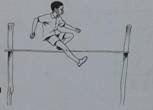
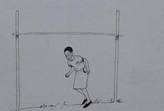
IMITATING ANIMAL MOVEMENT AT DIFFERENT HEIGHT LEVELS



CREATING ARTISTIC SHAPES AND MOVEMENTS
One can create different shapes and movements when drawing pictures and illustrations. Such drawings can be done by joining lines and circles.
Lines and circles can produce shapes when they are joined in different ways and at different angles.
These shapes are known as geometrical figures and they can be in the form of circles, rectangles, squares and many others.
One can also create shapes by knitting and sewing.
When these shapes are joined together in different ways and at different angles, they can make figures such as people, houses, trees, animals and other things.
DRAWING GEOMETRICAL SHAPES





CREATING SHAPES USING THE BODY

DESIGNING TOYS OF DIFFERENT SHAPES

SEWING TOYS

Steps for sewing and stuffing toys
- lay the designs on pieces of fabric and pin them together
- cut out the pattern pieces
- mark the stitching line
- mark the features on the toy and position of an opening to be used for stuffing
- tack and stitch using a running stitch, leaving an opening for stuffing
- clip and snip seams where necessary and turn the toy to the open side
- stuff the toy and close the opening by over-sewing the opening
KNITTING TOYS


A BEAN BAG
- cast on 48 stitches
- using garter stitches, knit until the work measures 16cm long
- cast off
- fold and join the sides using the running stitch
- stuff and over-sew the opening
A KNITTED DOLL
- cast on 10 (8, 6) stitches and knit in garter stitch until the work measures 11 (7, 5) cm long (this forms the leg)
- knit another leg to match
- knit he body using the following steps
- with both legs on one needle, knit right across to join them together
- carry on knitting until the work measures 35 (25, 19) cm long. this will be the front, head and back
- divide the stitches in half for the back of the legs
- using half of the stitches, knit until the work measures 11 (7, 5) cm long and then cast off
- re-join the wool to the remaining half of the stitches; knit half of the stitches and knit the second leg to match
- knit the arms using the following step
- cast on 16 (14, 12) stitches and knit in garter stitch until work measures 7 (5, 4) cm long.
- cast off
- knit another arm to match
- make up (finish off) the toy by folding the knitted work in half and over-sewing round the edge leaving space for stuffing as in the illustration below
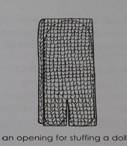
- round off the ends of the legs for feet and head by doing the following
- turn the knitted doll inside out
- stuff the head firmly and then tie it tightly round the neck with a piece of wool
- stuff the rest of the body and legs and sew up the opening
- sew up the side of the arms and round off the corners for hands, as shown below
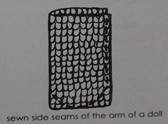
- turn the arms inside out and stuff them
- sew the arms on the body at the shoulders
- embroider the features of the doll (eyes, nose and mouth)
IMPORTANCE OF MAKING TOYS BY CHILDREN
- Making toys helps the children in developing their creativity
- Making toys helps children in developing their imagination
CREATING GAMES USING TOYS
There are many games that can be played using toys.
RISKS AND SAFETY PRACTICES IN ARTS AND SPORTS
Risks in Using Equipment
The table below shows sources of risks in various sporting and artistic activities
ACTIVITY |
SOURCE OF RISKS |
Weaving |
Equipment such as bamboos and chisongole |
Knitting |
Equipment such as knitting needles |
Sewing |
Equipment such as sewing needles and pressing iron |
Carving |
Tools such as adzes (kasemasema) |
Athletics: track events (running activities. For example, relay race and cross country) |
Small running lanes, stones, litter, sharp objects, bricks, rough surfaces, lack of warm up and cool down activities |
Athletics (throwing events) for example, javelin, discus, shot put |
Poor condition of equipment, poor handling of equipment and slippery and rough surfaces |
Ball games |
Sports surfaces in poor conditions, lack of warm up and cool down activities, wrong pressure and size of balls, poor condition of balls |
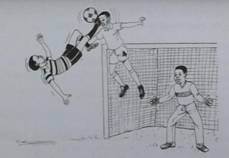
Strategies for Reducing Risks
- Doing warm ups and cool downs
- Thrower should always be in front of others
- Clear the area where the activity will be done
- Always use equipment that is in good condition
- Store and keep equipment safely after use to prevent wrong use
- Proper handling of sharp tools, for example, needles
- Wearing a thimble when sewing
- Proper sharpening of tools
- Splitting and processing bamboos with care in weaving The table below shows strategies that can be used to reduce risks
ACTIVITY |
RISKS |
STRATEGY THAT CAN BE USED TO REDUCE RISKS |
Playing ball games |
Getting fractures, cuts and scratches |
|
Ball hitting players |
|
|
Players hitting each other |
- Strictly observe the rules of the game |
|
Sewing |
Needle pricking ones finger |
- Use a thimble to protect the middle |
Needle pins piercing others or oneself |
|
|
Cutting oneself or others |
|
|
Burning oneself or others |
|
|
Athletics |
Hitting one another due to bunching (many people being together without enough personal and general space) |
|
Collapsing |
|
|
Carving |
Getting cuts or tears |
|
The table below shows some of safe practices in different activities
ACTIVITY |
SAFE PRACTICES |
Javelin |
|
Discus |
- Use discus without cracks and worn out reams |
The shot |
- Hold the shot with a firm grip |
Jumping events |
- Have a soft landing area |
Athletics |
|
Basketball |
- Minimise contacts among players |
Netball |
|
Volleyball |
|
Field hockey |
|
Football (soccer) |
|
Gymnastics |
|
UNIT 2 PARTICIPATING AND COLLABORATING IN SPORTS AND ARTS
Sports and artistic performances
There are different types of sports and arts in which learners can participate. These include: football, netball, singing, dancing, and poetry.
The activities can be done for pleasure, leisure or entertainment.
FOOTBALL
Football is played for pleasure and entertainment.
IMPORTANCE OF PARTICIPATING IN FOOTBALL
- It fosters team spirit
- It promotes cooperation
BASIC SKILLS IN FOOTBALL
- Dribbling
- Passing
- Heading
- Shooting
- Goal keeping
NETBALL
Netball is played for pleasure and entertainment
IMPORTANCE OF PARTICIPATING IN NETBALL
- It fosters team spirit
- It promotes cooperation
BASIC SKILLS IN NETBALL
- Passing
- Catching
- Marking
- Shooting
- Goal keeping
The learners need to practice the basic skills first in both football and netball before participating in a real game.
Both games need cooperation and team spirit if they are to be played successfully.
SINGING
Singing is a form of communication.
Songs can be used to pass on messages on issues such as health and gender.
Songs are an effective medium of communication because they easily draw the attention of the audience.
DANCING
Dancing is one of the oldest human activities.
In Malawi, some dances are based on specific historical events. For example, Beni is based on the parades of British soldiers, ngoma or Ingoma is a war dance.
Tchopa and Likhuba are traditional dances associated with rain-making ceremonies.
SPORTS ATTIRE AND COSTUMES
Sports attire and costumes are the type of dress that identifies people with a certain kind of sporting activity or artistic performance.
Sports attire and costumes can be made using locally available materials.
This can give an opportunity to the makers to acquire various skills such as designing, creativity and production of various items
One the sports attire and costumes have been made, there is need to take care of them.
This can be done through proper storage so that the items can be used many times before they wear out.
IMPORTANCE OF SPORTS ATTIRE AND COSTUMES
- Giving identity
- Adding beauty
- Allows freedom of body movement
- Attracting viewers
ARTISTIC ACTIVITIES THAT REQUIRE COSTUMES
- Drama
- Poetry (poem recitals)
- Story telling
- Traditional dance
- Choir singing
LOCAL MUSICAL INSTRUMENTS
A musical instrument is an instrument created or adapted to make musical sounds. In principle, any object that produces sound can be considered a musical instrument.
Local musical instruments can be classified into:
- Tuned musical instruments
- Untuned musical instruments
Tuned musical instruments are those which produce various pitches.
Examples of tuned musical instruments are Nkangala, the flute, string-bass and guitar.
Untuned musical instruments are those which produce one pitch. Examples of untuned musical instruments are shakers, rasps and rattles.
OCCASIONS WHEN MUSICAL INSTRUMENTS ARE USED
- Weddings
- Funerals
- Initiation ceremonies
- Political gatherings
- Festivals
- Installation of chiefs
SOME MATERIALS FOR MAKING MUSICAL INSTRUMENTS
- Gallons
- Plastic papers
- Buckets
- Sticks
- Wood
- Strings
- Bones
- Bamboo
- Reed
- Nails
- Wires
- Animal hides
MAKING LOCAL MUSICAL INSTRUMENTS
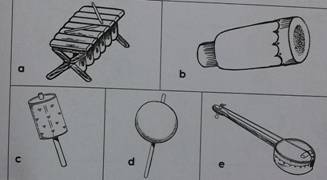
PLAYING MUSICAL INSTRUMENTS
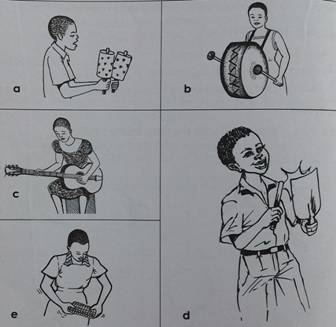
Musical instruments can be played by:
- Plucking (e.g a guitar and banjo)
- Beating (e.g a drum)
- Blowing (e.g a trumpet)
- Shaking (e.g a rattle)
- Pressing (e.g a piano)
- stroking
IMPORTANCE OF MUSICAL INSTRUMENTS
- they complement human voice
- they add harmony in music
- they reflect the cultural history of an ethnic group
- they attract attentiveness and concentration of the musical players and listeners
- they foster self-expression
- they relieve stress
- they add beauty in music
- they promote social skills
- they boost listening skills
- they promote discipline
UNIT 3 SELF EXPRESSION THROUGH ARTWORK
There are various artworks which learners can produce to express and communicate their feelings. These include songs, sports, stories, sewing, knitting, plaiting and modelling.
REPETITIONS AND CONTRASTS IN ARTWORK
Repetitions and contrasts in these artworks are used in order: (Importance of repetitions and contrasts)
- To express and communicate various ideas effectively
- To emphasize certain ideas
- To make certain areas of an artwork stand out
- To add beauty to artworks
- To express feelings
- To add visual intensity and interest to art pieces
REPETITIONS AND CONTRASTS IN ART AND CRAFT

MODELLING A POT
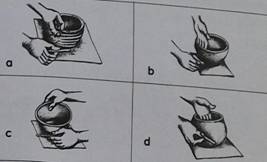
FORMS OF COMMUNICATION THROUGH ARTWORK
Communication is passing out information, ideas, feelings or wishes from one person to another. Communication can be verbal or non-verbal.
Songs, plays, cartoons and puppets can be used to communicate verbally or non-verbally.
SINGING
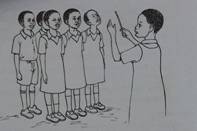
DRAWING CARTOONS
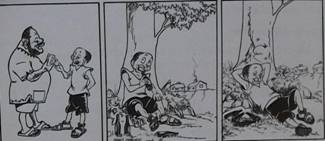
MAKING PUPPETS
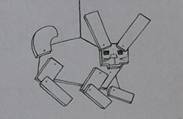
UNIT 4 SOLVING CHALLENGES IN EVERYDAY LIFE CHALLENGES IN EVERYDAY LIFE AND THEIR SOLUTIONS
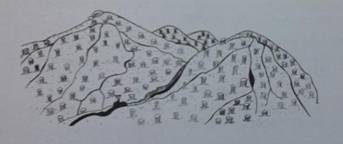
CHALLENGES IN LIFE
- Floods
- Droughts
- Epidemics
- Rapid population growth
- Diseases
- Food shortages
Artistic representations such as plays and posters can be used as a way of dealing with these challenges.
POSSIBLE SOLUTIONS TO THE CHALLENGES
- Practising family planning
- Planting more trees
- Using environmental friendly methods of farming
- Doing physical exercises
- Eating balanced diet food
- Living a health life
UNIT 5 PRODUCING VARIOUS ITEMS FOR THE COMMUNITY WEAVING BROOMS
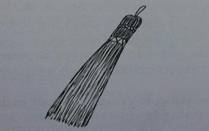
Guidelines for weaving brooms
- prepare dry palm leaves into thick edged weaving strips by using a knife
- get a bundle of the thick edged strips and tie in the midpoint
- bend the strips from the midpoint towards one side
- tie at two or more places to make a handle and a sweeper
- weave through the ties with palm leaf strips
- trim the ends of the strips with a sharp knife
PLAITING DOORMATS

Guidelines for plaiting doormats
- arrange the fibre into three strands
- plait the strands into a plaid of desired length
- coil the plaited cord and join the rows using running stitches
MODELLING TOYS USING LOCAL MATERIALS


Guidelines for modelling grass toys
- Shred maize sheaths/palm leaves into small pieces lengthwise using a knife.
- tie the bottom end of the maize sheaths/palm leaves firmly to form a broom-like structure
- fold the longer end over the tied end, as is done when weaving brooms, to form the head of the toy
- after all the maize sheaths/palm leaves have been turned down, tie again to form a neck
- Pull out some maize sheaths/palm leaves into three groups and plait for a length of about 10cm to form a trunk. Then divide them into two groups to form legs (hind limbs). Plait the legs and do the same with the arms.
CARVING SPOONS

Guidelines for carving spoons
- take a piece of wood and chop it into a plank
- smoothen the plank
- draw the required size of the wooden spoon on the plank
- use an adze (kasemasema) and chisel to carve the spoon
- smoothen the spoon using a broken piece of glass or a sharp knife
COSTING ITEMS
When costing items consider the following:
- The materials used
- The cost of materials used
- Time it took to make the items
- Labour involved in making the items
- Size of the items
- Quality of the items
- Demand of the items
- Supply of the items
- Affordability of the customers
MARKETING ITEMS
Importance of Carrying out a Market Research
- To understand what people’s likes are
- To discover where particular artefacts are popular
- To convince people that they will not regret after buying the artefacts
Marketing Skills
- Carrying out a research
- Costing the artefacts
- Displaying them
- Marketing them
UNIT 6 VARIOUS ARTISTIC ACTIVITIES PRODUCING AND MARKETING ART ITEMS
There are many artistic activities which can help one to develop skills for producing and marketing artistic items.
Some of these activities are composing songs, acting, drawing, sewing and knitting.
COMPOSING A SONG
Guidelines for composing a song
Step 1 What message do you want to convey in the songs Step 2 Target audience
Step 3 What mood of the song do you want to convey your message through? Step 4 Identify a time for your song
Step 5 Find words to the tune of your song (consider things such a rhymes in your words of the time, just like in poetry)
FACTORS TO CONSIDER WHEN COMPOSING A SONG
- Age of the target group
- Cultural background of the target group
- Religion of the target group
- Language spoken by the target group
- Likes and dislikes of the target group
KNITTING A BABY'S BOOTIES AND BONNET

PATTERN FOR KNITTING THE BONNET MATERIALS
- 1 ball yarn of 50gm
- No. 3.5 mm sized needles
PATTERN
- cast on 82 stitches
- 1st row: knit
- 2nd row to 10th row: purl
- 11th and alternate row: purl
- 12th and every alternate rows to form stocking stitch
- continue in stocking stitch until the work measures 17cm long from the beginning
- fold the bonnet in half with a wrong side out
- using the over-sewing, stitch, join the sides
- make a hem from one end of the bonnet to the other across the stitched seam for the chord
- using four strands of knitting wool, twist a chord to be slotted in the hem
PATTERN FOR KNITTING THE BOOTIES
- cast on 36 stitches
- 1st row to 10th row: knit
- 11th to 20th row: stocking stitch
- 21st row: k1, wfd k2 together*, repeat from * to * to the last stitched, knit
- 22nd row to 25th row: knit
- 26th row: k25 stitches and turn
- 27th row: purl 14 stitches and turn
- continue in stocking stitch on these 14 stitches for 20 rows
- knit 14, purl and k11 stitches from the sides of foot
- knit to end
- pick up and purl stitches from one side of the foot; purl to the end (58 stitches)
- work 10 more rows in garter stitch
- cast off all stitches
- using oversewing, join the two sides on the wrong side
- using 4 strands of knitting wool, twist a chord to be slotted in the holes provided in the booty
ABBREVIATIONS IN KNITTING
C/on - cast on
C/off - cast off
Sts-stitches
k-knit
p-purl
Wrd -wool forward
tog - together
alt - alternate
St st - stocking stitches
beg - beginning
incl - including
rep - repeat
*to*- beginning from - to -
SEWING A MAGYER DRESS/COLLARLESS MAGYER SHIRT
Process for constructing a Magyer dress/collarless Magyer shirt
- pre-shrink cotton fabric and hang out to dry
- pull all corners of the fabric diagonally to straighten the fibre. Press with an iron
- lay out the fabric with the wrong side out and place pattern on the fabric
- pin pattern piece to fabric and cut 1 piece of the garment as in the following illustration
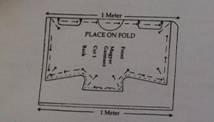
- assemble the garment by making a slash opening 10cm long in the centre of the neckline
- cut out crossway strips and join them. place the right sides of the crossway strip along the neckline using back stitch
- trim one side of the seam allowance to remove the bulk of the finished binding
- snip the curved edge close to the stitching line to relieve strain
- turn the binding over so that it shows equally on both sides as shown in the illustration below

- tack the binding down and hem in position on the wrong side, picking up the back stitches
- bind the sleeves using the same procedure as in Step e) above
- work side seams by making open seams on both sides of the garment. Stitch using the back stitch
- snip the curved areas as illustrated below

- neaten the seams
- turn a small fold at the bottom of the garment and press. make a second fold for the hem of about 2cm. Hold down the hem using hemming stitches
ATTACHING A BUTTON
Procedure for attaching a button to the shirt or dress
- attach a button to the garment by fastening a piece of thread at the required position of the button
- place the centre of the button over the fastened thread, and bring the thread through the first hole to the right side of the button
- place across the button, a pin, match stick or knitting needle according to the length
- pass the thread across the pin and through the second hole to the back of the fabric
- repeat this as often as necessary for the size of the button, keeping the stitches on the wrong side, one lying over the other
- remove the pin, bring the needle out between the button and the fabric. pull the button to the end of the long stitches formed
- wind a thread 3 to 4 times round the stem of stitches formed. Take the needle through the back of the fabric, loop over the stitches and fasten off.
WORKING A LOOP
STEPS TO MAKE A WORKED LOOP
- measure the diameter of the button to mark the place of the loop using pins
- fasten the thread with a double stitch at one pin and work strands back and forth from pin 1 to pin 3 passing the thread round pin 2 and finishing at pin 3 as illustrated below
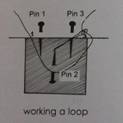
- repeat stranding as often as the size of the loop requires
- remove the pins
- turn the loop round and work the loop stitches over the stranded threads as illustrated below

CUTTING AND ATTACHING A SIMPLE APPLIQUE PIECE
Cutting
Step 1 Trace or draw desired shapes on paper
Step 2 Cut around the outlines to get the pattern of the required design Step 3 Trace out the design on the contrasting colour of fabric
Step 4 Cut neatly along the outline
Step 5 If a motif is cut from the printed fabric, cut it following the edges of the chosen design
Attaching
Step 1 Place the cut out design in position on the right side of the garment. Pin and tuck Step 2 Using hemming stitches, stitch closely along the edge of the applique
Step 3 Remove the tucking
Step 4 Press the garment and air it
Step 5 Prepare price labels for the garments constructed Step 6 Attach the price labels to the garments
Step 7 Display and mock market the garments
REFERENCES
MIE (2008); Standard 5 Teacher’s Guide
MIE (2008); Standard 5 Learners’ Book ODL Expressive Arts Handbook
The Internet
STANDARD 5 by emmanuelkapachika SCIENCE AND TECHNOLOGY
MEANING OF A SCIENTIFIC INVESTIGATION
What is an investigation ?
An investigation is a way of getting information or knowledge What is a scientific investigation ?
A scientific investigation is a process in which one design and carries out experiments to obtain information or knowledge
STAGES OF A SCIENTIFIC INVESTIGATION
.knowing the problem
.making a prediction
.planing the investigation
.carrying out the investigation
.interpreting the result
.making conclusion
WORM INFECTIONS TYPES OF WORMS
.round worms
.tape worms
.hook worms ROUND WORMS
round worm
SIGNS AND SYMPTOMS OF ROUND WORMS
.nausea
.vomiting
.discomfort in the stomach
.weakness of the body
.swollen belly
.fever
.obstruction of the intestine
.loss of appetite
.presence of eggs in faeces
PREVENTION AND CONTROL OF ROUND WORMS
.using the toilet
.washing hands after using the toilet
.keeping finger nails short and clean
.washing fruits and vegetables
.seeking treatment from the hospital
.washing hands before eating food TAPE WORMS
These worms infect human beings, pig,cattle and fish
tape worm
SIGNS AND SYMPTOMS OF TAPE WORMS
.pain in the stomach
.anemia
.loss of weight
.diarrhoea
.patient looking pale
PREVETIONS AND CONTROL OF TAPE WORMS
.cook meat and fish thoroughly
.always use the toilet
.people should follow rules of hygiene in the home HOOK WORMS
There are more common in adult than in children
hook worm
SIGNS AND SYMPTOMS OF HOOK WORMS
.anaemia
.diarrhea
.abdominal pain
.weakness
.loss of weight
.weakness due to loss of blood
PREVENTION AND CONTROLLING HOOK WORMS
.avoiding walking with bare feet in water or wet soil
.always use the toilets
FOOD AND HEALTH
What is food ?
Food is anything which when eaten or drunk provides the body with nutrients for it to function properly
NUTRIENTS FOUND IN THE FOOD GROUP
.carbohydrates
.fats
.proteins
.minerals
.vitamins
.water
What is health ?
Health is the status of the body being able to function properly CLASSIFICATION OF FOOD
.energy giving food
.protective food
.body building food ENERGY GIVING FOOD
These provide the body with energy The food which provide with energy
.maize
.rice
.cassava
.sorghum
.Millet
.potatoes
.honey
.sugar cane PROTECTIVE FOODS
These protect the body from infections
The food which protect the body from infections
.pawpaw
.bwemba
.malambe
.bonongwe
.chisoso
.
BODY BUILDING FOODS
These provide the body with material for body building and repair of warn- out tissues Examples of body building food
.meat
.fish
.eggs
.grasshoppers
.flying ants
.mice
.beans
.peas
SIX FOOD GROUPS
FOOD GROUP |
NUTRIENTS FOUND IN THE FOOD GROUP |
SOURCES OF NUTRIENTS |
Vegetables |
Vitamins and minerals |
dark green leafy vegetables such as; ,bonongwe,lun,chisoso,pum pkin leaves |
Fruits |
Vitamins and carbohydrates |
Fruits such as; oranges, water melons,bananas,masuku,ka tope,nthudza |
Legumes and nuts |
Proteins, fats and carbohydrates |
Beans,peas,pigeon peas,cow peas, groundnuts, macadamia nuts |
Food from animals |
Proteins and fats |
Meat,insects, fish,milk,eggs and cheese |
Fats |
Fats |
Avocado pears,animal fats,cooking oil from cotton seed or sun flower seeds |
Staples |
Carbohydrates |
|
|
|
Grains such as; maize,rice,Millet and sorghum |
|
|
Starchy roots such as; cassava, potatoes and yams |
COMMON FOOD TABOOS AND BELIEFS
A baby should not be given its mother's breast milk if the mother spends a night away from the child. It is believed that the breast milk is rotten and will make the child sick
A pregnant woman should not eat tomatoes because she will bear a child with skin rashes.
Pregnant women should not eat sugarcane because the child will have a powdery skin like sugarcane.
Boys should not eat ground beans because they will be short at a battle field. Children should not eat eggs because they will have stomach problems.
A pregnant woman should not eat eggs because she will bear a child without hair. BAD FOOD HABITS
Lack of variety in one's food choice
Serving the best portions of food to adults especially men and visitors.
Eating from one plate with Small children
Feeding infants and young children on gravy only instead of meaty parts Introducing porridge to young babies as early as the first month after birth Believing that maize is the only staple food that can be saved during meals Adding alot of fat or oil in food when cooking.
Eating only one meal a day
EFFECTS OF FOOD TABOOS AND BELIEFS
A mother may give birth to a weak baby. Malnutrition in young children and pregnant women. There is stunted growth in young children.
There is low productivity.
INDIGENOUS TECHNOLOGIES
EXAMPLES OF INDIGENOUS TECHNOLOGIES
- man
- nkhokwe
- chikwatu
- mud stove
- charcoal stove
- winnower
- adze
- grinding stone
- bow and arrow
- canoe
- fish trap ( mono)
USES OF INDIGENOUS TECHNOLOGIES
- Food processing
- Separation of mixtures
- Water purification
- Cooking
- Loading logs in a lorry
- Sawing timber
- Storage
- Shelling maize
- Construction
TECHNOLOGICAL INNOVATIONS
TECHNOLOGIES USED IN THE COMMUNITY
What is technology ?
Technology is the use of scientific knowledge and equipment in order to solve everyday problems
TECHNOLOGIES AND THEIR RELATED PROBLEMATICAL
Technology |
Problems of the technology |
Ox- cart |
|
Bicycle |
∙ |
Can carry limited laggage and number of people. |
Hoe |
∙ |
Is too slow for cultivation |
Plough |
∙ |
Cannot be used without cattle or similar animals |
Fertilizer |
∙ ∙
∙ |
Can be too expensive Pollutes water resources when it rains |
Manure |
∙ |
May require a lot of work to produce and apply. |
Mortar and pistle |
∙ |
It too slow for processing food. |
Fishing net |
∙
∙
∙
∙
∙
∙ |
Can be too expend.
Can be difficult to determine.
Can be too expensive to maintain.
Difficult to target.
May be breeding places for flies that are vectors of many diseases |
Medical herbs |
||
Maize mill |
||
Catapult |
||
Rubbish pits |
||
Musical instruments |
∙
UNIT 1 LOCATION OF A DISTRICT
UNIT 2 POPULATION
UNIT 3 CIVIC RIGHTS AND RESPONSIBILITIES
UNIT 4 MORAL VALUES
UNIT 5 MAJOR PHYSICAL FEATURES IN A DISTRICT
UNIT 6 THE EARLY KINGDOMS OF MALAWI 7
UNIT 7 SOIL 10
UNIT 8 DISTRICT ADMINISTRATIVE STRUCTURE 10
UNIT 9 GENDER 14
UNIT 10 TRANSPORT AND COMMUNICATION IN THE DISTRICT 15
UNIT 11 INSTITUTIONS AND DEPARTMENTS IN THE DISTRICT 16
UNIT 12 TRAFFIC RULES 19
UNIT 13 SAFETY AT WORK 21
REFERENCE 22
FIRST EDITION 2018
UNIT 1 LOCATION OF A DISTRICT
THE CARDINAL POINTS
The location of a district can be established in relation to neighbouring districts. The learners can use the map
of Malawi to locate their district. The cardinal points can also be used to locate the direction of the district.
The four main cardinal points north, south, east and west.
LOCATION OF DISTRICTS
There are 28 districts in Malawi. These districts are located in the 3 regions: the northern region, the central
region and the southern region.
DISTRICTS IN THE NORTHERN REGION
1. Chitipa
2. Karonga
3. Rumphi
4. Mzimba
5. Nkhatabay
6. Likoma
DISTRICTS IN THE CENTRAL REGION
1. Kasungu
2. Dowa
3. Lilongwe
4. Mchinji
5. Salima
6. Nkhotakota
7. Ntchisi
8. Ntcheu
9. Dedza
DISTRICTS IN THE SOUTHERN REGION
1. Mangochi
2. Balaka
3. Neno
4. Mwanza
5. Chikwawa
6. Chiradzulu
7. Nsanje
8. Blantyre
9. Zomba
10. Machinga
- Page 1 of 22
SOCIAL STUDIES
FOR
STANDARD 5
BY ZIKOMO MASESE BANDA 0999 24 67 69
Page 2 of 22
Written by Zikomo Masese Banda
TABLE OF CONTENTS
UNIT PAGE
UNIT 1 LOCATION OF A DISTRICT 3
UNIT 2 POPULATION 4
UNIT 3 CIVIC RIGHTS AND RESPONSIBILITIES 5
UNIT 4 MORAL VALUES 5
UNIT 5 MAJOR PHYSICAL FEATURES IN A DISTRICT 6
UNIT 6 THE EARLY KINGDOMS OF MALAWI 7
UNIT 7 SOIL 10
UNIT 8 DISTRICT ADMINISTRATIVE STRUCTURE 10
UNIT 9 GENDER 14
UNIT 10 TRANSPORT AND COMMUNICATION IN THE DISTRICT 15
UNIT 11 INSTITUTIONS AND DEPARTMENTS IN THE DISTRICT 16
UNIT 12 TRAFFIC RULES 19
UNIT 13 SAFETY AT WORK 21
REFERENCE 22
FIRST EDITION 2018
WHATSAPP # 0991295167
Page 3 of 22
UNIT 1 LOCATION OF A DISTRICT WRITTEN BY ZIKOMO MASESE BANDA
THE CARDINAL POINTS
The location of a district can be established in relation to neighbouring districts. The learners can use the map
of Malawi to locate their district. The cardinal points can also be used to locate the direction of the district.
The four main cardinal points north, south, east and west.
LOCATION OF DISTRICTS
There are 28 districts in Malawi. These districts are located in the 3 regions: the northern region, the central
region and the southern region.
DISTRICTS IN THE NORTHERN REGION
1. Chitipa
2. Karonga
3. Rumphi
4. Mzimba
5. Nkhatabay
6. Likoma
DISTRICTS IN THE CENTRAL REGION
1. Kasungu
2. Dowa
3. Lilongwe
4. Mchinji
5. Salima
6. Nkhotakota
7. Ntchisi
8. Ntcheu
9. Dedza
DISTRICTS IN THE SOUTHERN REGION
1. Mangochi
2. Balaka
3. Neno
4. Mwanza
5. Chikwawa
6. Chiradzulu
7. Nsanje
8. Blantyre
9. Zomba
10. Machinga
11. Thyolo
Page 4 of 22
12. Phalombe
13. Mulanje
UNIT 2 POPULATION
POPULATION FIGURES IN THE DISTRICT
Each area, village, town, district, region or country has a different population size.
FACTORS INFLUENCING POPULATION CHANGE
Births and deaths
Migration (emigration and immigration)
Disasters
EFFECTS OF POPULATION CHANGES
An increase in population of an area may lead to:
shortage of social services such as schools and hospitals
environmental damage through soil erosion and deforestation
shortage of natural resources such as water
shortage of employment
low standard of living
A decrease in population of an area my lead to:
shortage of human resources
greater availability of land for settlement and farming
greater availability of social services
ENVIRONMENTAL DAMAGE OR ENVIRONMENTAL PRESSURE
Some of the effects of population change include damage or pressure on the environment.
ENVIRONMENTAL SUSTAINABILITY AND POPULATION CHANGE
Some of the ways of sustaining the resources in the environment are:
planting trees
planting grass
avoiding bushfires
following good crop husbandry methods
avoiding using poisonous chemicals when fishing
Page 5 of 22
UNIT 3 CIVIC RIGHTS AND RESPONSIBILITIES
POWER, AUTHORITY AND STATUS
The terms ‘power’ and ‘authority’ are often used interchangeably. However, they have different meanings.
Power is the ability to use, control or direct something or someone.
On the other hand, authority is power combined with the right to use the power.
This right to exercise power comes from customs, laws, appointments or assignment.
People in power and authority use their status for the benefit of the people.
Status is the position one is holding in society.
THE USE OF POWER AT FAMILY, SCHOOL AND COMMUNITY LEVELS
In the family, parents use their position to discipline their children and provide for their daily needs. At
school, the Headteacher and teachers ensure that learners are given meaningful instruction. In the
community, village heads, ward councillors and members of parliament initiate development activities which
benefit many people. At national level, the president and cabinet unsure that the rights and interests of the
people are promoted and protected.
Authority can also be used to provide order and security and to resolve conflicts peacefully among people.
ABUSE OF POWER AND AUTHORITY
Some people use their position or status for personal gain. This is known as abuse of power.
This means that power is not used for the intended purpose. The most common form of abuse of power is
corruption.
CONTROL OF ABUSE OF POWER AND AUTHORITY
There are several institutions and organisations which help to check the abuse of power such as Ombudsman,
Law Society and Centre for Advice Research and Education on Rights (CARER), Anti-Corruption Bureau (ACB)
and the Police. People can report to these organisations and institutions when the abuse of power has
occurred. It is everyone's responsibility to prevent the abuse of power.
UNIT 4 MORAL VALUES
ACTS OF BRAVERY AND COURAGE
Bravery is when one is ready to face and endure great difficulties. In the communities, there are people who
demonstrate bravery. Some brave acts include diving into water to rescue a person who is drowning, entering
Page 6 of 22
a house which has caught fire in order to rescue a person or property, scaring off or fighting big snakes and
other animals which threaten people's lives.
IMPORTANCE OF BRAVERY AND COURAGE
bravery helps to promote peace in the society
bravery helps to promote cooperation in the society
bravery promotes fairness in the society
There are some Malawians who have showed bravery and courage.
These include John Chilembwe, Hastings Kamuzu Banda, Chakufwa Chihana and Bakili Muluzi.
They have suffered or died for the sake of others.
The government has set aside some days like the Martyrs’ Day and Poppy Day to remember such people.
On these days, activities such as singing songs of praise, military displays, poetry recitals, radio programmes
and banner messages.
UNIT 5 MAJOR PHYSICAL FEATURES IN A DISTRICT
MAJOR PHYSICAL FEATURES
mountains
hills
rivers
lakes
plateaus
plains
rift valleys
IMPORTANCE OF MOUNTAINS AND HILLS
they are sources of rivers and streams
they are sources of trees.
they are homes of wild animals
they make a country look beautiful
they attract tourists who bring in foreign revenue.
some place are named after mountains for example Mulanje, Ntchisi, Zomba, Dedza, Nyika Plateau
and Machinga.
some mountains, hills and plateaus form boundaries of countries, for example, Kirk Range in Ntcheu
District.
Page 7 of 22
IMPORTANCE OF LAKES AND RIVERS
they provide water
they are sources of fish
they can be used for transportation
they can be used for irrigation
some lakes and rivers can be used for generating electricity
they are homes of aquatic animals
some lakes and rivers offer tourist attraction
some places are named after rivers, for example, Lilongwe, Mzimba
some lakes and rivers form boundaries of countries, for example, Songwe River, Lake Malawi
UNIT 6 EARLY KINGDOMS OF MALAWI
The Maravi and the Nkhamanga were the earliest kingdoms of Malawi. Some of these kingdoms were
established during the time of the Akafula. The Akafula were the earliest settlers in Malawi.
ORIGINS OF THE EARLY KINGDOMS OF MALAWI
MARAVI KINGDOM
The Maravi, who are now known as the Chewa, originally came from Uluba in Katanga province of Zaire. They
left Zaire in groups between 1200 and 1500 AD.
The main reasons for their migrations were tribal wars, and a shortage of land for grazing and farming.
The kingdom extended from the Luangwa Valley in Zambia to the west of present Malawi, beyond Ruo River
in the east, Dwangwa River in the north and Zambezi River in the south.
NKHAMANGA KINGDOM
The Nkhamanga lived in the northern Malawi in family clans. Each clan had a leader. They settled in the area
between Nyika Plateau to the north, Dwangwa River to the south, Bisa territory in Zambia to the west and
Lake Malawi to the east.
The oldest family groups were the Mkandawire, Luhanga, Kachali, Kumwenda, Msowoya, Harawa, Nyanjagha
and Mwalweni. All these spoke Chitumbuka.
The Balowoka came from Ubena south of the present Tanzania around 1850 AD and joined Nkhamanga. The
Balowoka soon became leaders and established their political structure with its headquarters at Thurwe near
Bolero in Rumphi District.
Page 8 of 22
THE POLITICAL STRUCTURE OF THE MARAVI KINGDOM
The Maravi were organised under a political system headed by their ruler, the Kalonga. The Kalonga was from
the Phiri clan. He was the supreme head of the judiciary and performed ritual or religious duties during
religious or social ceremonies. He also held all the territorial powers. He was assisted by subordinate chiefs
called Eni dziko.
These were district rulers and some formed king's council. The Nyakwawa (village heads) were responsible
for villagers (anthu a m'mudzi)
THE POLITICAL STRUCTURE OF THE NKHAMANGA KINGDOM
The political structure of the Nkhamanga Kingdom had Chikulamayembe as king, Balowokas as vassals
(juniors) and were in control of trade in their areas. The Nkhamanga clan were appointed as Indunas (subchiefs)
FACTORS THAT LED TO THE GROWTH OF THE EARLY KINGDOMS IN MALAWI
Most of the Maravi people emerged as leaders over the local people because they had knowledge of God,
traditional medicine, farming, taming animals, trade in ivory and a well-organised political structure.
The Nkhamanga earned their living through subsistence farming. They grew millet and other grain crops.
Hunting and iron smelting were other means of living. With the coming of Balowoka, Nkhamanga grew into a
commercial kingdom. Their leader was given the title Chikulamayembe meaning “carrier of hoes". The
Nkhamangas traded in hoes, knives, beads, cloth, salt and other goods in exchange for ivory and animal skins
with the local people. Chikulamayembe became very powerful and popular.
Kalonga
Eni dziko
Eni mzinda
Anthu a m’mudzi
Nyakwawa
Chikulamayembe
Balowokas
Indunas
Page 9 of 22
THE FALL OF THE MARAVI KINGDOM
The Maravi Kingdom fell because of political problems and invasions by other tribes.
a. Political structure
The creation of new chieftains led to disloyalty to the Kalonga. Subordinate chiefs far away from the Kalonga
traded directly with the Arabs and Portuguese. Some shrines stopped paying their loyalty to the Kalonga
during religious ceremonies.
b. The Ngoni and Yao invasions
The Ngoni invaded the Chewa, and later, the Yao also invaded the Chewa.
THE FALL OF THE NKHAMANGA KINGDOM
The Nkhamanga Kingdom fell because of the following reasons:
There was a lack of a standing army and strong leadership
There was a lack of respect for the king by some local chiefs
Kaunga Nyirenda, a Mlowoka, invaded the kingdom
The Swahili, Arabs and Portuguese took over trade.
Later the Ngoni fought and defeated Chikulamayembe
CONTRIBUTIONS OF THE EARLY KINGDOMS TO THE PRESENT MALAWI
1. THE MARAVI KINGDOM
The Maravi kingdom contributed the following to the present Malawi
a settled life
a political structure
an organised religion
the use of tradition medicine
Chinyanja now known as Chichewa, one of Malawi’s official language
2. THE NKHAMANGA KINGDOM
The Nkhamanga Kingdom also made some contributions to the present Malawi
agricultural practices
hunting
iron smelting
trade in ivory, animal skins and foreign goods
Chitumbuka which is one of Malawi’s local languages.
Page 10 of 22
UNIT 7 SOIL
Soil is the particles that make up the surface of the earth.
TYPES OF SOIL
There are many types of soils with different characteristics.
The major ones are:
sand
clay
loam
Some soils are made up of small particles while others are made up of large particles.
IMPORTANCE OF SOIL
plants grow on soil
bricks are made from soil
clay pots are made from soil
some insects and rodents live in soil.
DESTRUCTION OF SOIL
Soil can be destroyed in many ways such as:
through soil erosion
bush fires
cutting down of trees
removing of vegetation cover
loss of fertility
UNIT 8 DISTRICT ADMINISTRATIVE STRUCTURES
Administrative structures in Malawi are at national, regional, district and community levels.
The district structures serve the purpose of bringing government or development work closer to the local
communities. In each structure, people are appointed or elected to run the structure and have different
roles.
FUNCTIONS OF DIFFERENT ADMINISTRATIVE STRUCTURES
There are many roles and functions performed by the administrative structure in a district.
Page 11 of 22
Some functions for each structure are as follows:
THE TRADITIONAL STRUCTURE
The traditional structure:
ensures that customs and traditions are maintained
settles disputes among people in the area.
distributes land among people in the area
prioritises development work in the area
mobilises people in development work.
carries orders or concerns to or from the district development committee (DDC)
installs chiefs
The administrative structure of a district assembly
THE POLITICAL STRUCTURE
The political structure:
takes the concerns of people to assemblies (national, district)
organises and coordinates political meetings in the areas involved
represents people of the area in meetings or assemblies
mobilises people to perform development work
Professional
District Executive
Committee
Other civil servants
Area Executive
Committee (AEC)
5 representatives of interest groups
Traditional
Traditional Authority
Sub-traditional Authority
Group Village Head
Village Head
Villagers
District Assembly
District Commissioner
Chairperson of assembly
District Committee
Political
Constituency
Ward
Area committee
Branch committee
Project Committee Ordinary members
Village
Development
Committee (VDC)
Area
Development
Committee (ADC)
Page 12 of 22
PROFESSIONAL STRUCTURE
The professional structure
interprets government policies to people
advices community during prioritisation of projects in the district
supervises, monitors and evaluates projects
represents government or ministries during official districts meetings
Five members are appointed by the elected members to represent the interests of special groups of people
such as the physically challenged.
DISTRICT COMMISSIONER (DC)
The district commissioner:
settles land disputes in liaison with traditional leaders
registers marriages that are governed by English law
supervises development projects in the district
authorises the purchase of guns and ammunition
licenses the running of small businesses
organises national cerebrations at district level
MEMBER OF PARLIAMENT (MP)
A member of parliament:
takes the concerns of people to assemblies (national, district)
organises and coordinates political meetings in the areas involved
represents people of the area in meetings or assemblies
mobilises people to perform development work
A WARD COUNCILLOR (WC)
A ward councillor:
represents his or her ward at council meetings
presents problems of his or her ward to the council
interprets the council plans to the people of his or her ward
mobilises people on development work
supervises development activities in his or her ward
Page 13 of 22
The administrative structure of a city or municipal or town assembly
THE ASSEMBLY
Each district has its own assembly. In addition, the following are districts in their own rights in Malawi:
Blantyre, Lilongwe, Zomba and Mzuzu are city assemblies.
Balaka, Dedza, Karonga, Kasungu, Liwonde, Luchenza, Mangochi and Salima are town assemblies.
The administrative offices of the assembly are known as the secretariat. The secretariat is responsible for the
day-to-day running of the assembly.
The head of the secretariat in district assemblies is called the district commissioner and chief executive in
city, municipal and town assemblies.
ASSEMBLY COMMITTEES
Each assembly (council) has four committees which provide services to the local community.
These are:
education committee
health committee
works committee
finance committee
Professional
District Executive
Committee
Other civil servants
Area Executive
Committee (AEC)
5 representatives of interest groups
Traditional
Traditional Authority
Sub-traditional Authority
Group Village Head
Village Head
Villagers
City or Municipal Assembly
Chief Executive
Mayor
District Committee
Political
Constituency
Ward
Area committee
Branch committee
Project Committee Ordinary members
Village
Development
Committee (VDC)
Area
Development
Committee (ADC)
Page 14 of 22
THE LOCAL ASSEMBLY
The assemblies are established by law to provide various services in a district, town, municipality or city.
The assembly:
looks after the management of registered nursery and kindergarten schools, primary and community
day secondary school – done through the assembly education committee and the district education
office
supervises the running of registered government health services, dispensaries and maternity clinics –
also provides health education through the assembly health committee
provides and maintains water supplies. For example, boreholes, piped water projects and protected
wells
plans and implements community development projects.
looks after the welfare of street children including orphans and youth services
establishes woodlots, city parks, nature sanctuaries, and looks after forest resources.
constructs and maintains local roads (district, town and city)
plans social and economic development.
supports the local policies in maintaining peace and security
provides street lights
provides burial services and disposal of rubbish (refuse), sewerage
provides environmental education
manages ambulance and fire brigade services in cities
provides land for construction of commercial and residential buildings
establishes and manages sports stadiums, community halls, rest houses, market services, recreation
parks and play grounds, public toilets and beer halls or taverns.
raises funds through fees and taxes. For example, market fees, rest houses, maize mills, bottle stores,
ground rates or plots, burial services, refuse collection
makes by-law
makes assembly policies and decisions
UNIT 9 GENDER
FAMILY ROLES AND RESPONSIBILITIES REGARDLESS OF SEX
Gender roles are not uniform. They vary from society to society depending on the values attached to males
and females. Each society describes what is expected of males and females to young ones as different roles
and responsibilities are assigned to them. This is because the society sees these roles and responsibilities as
part of its cultural demands.
A family prepares young ones to take up roles and responsibilities based on traditions. Most Malawian
traditional practices dictate that females be subordinates to males. This has encouraged unfair distribution of
roles and responsibilities between males and females.
Page 15 of 22
EFFECTS OF GENDER INEQUALITY IN THE FAMILY, SCHOOL, COMMUNITY AND SOCIETY
some people suffer because they are given more work
some people are denied opportunities simply because of their sex
some people have a lot of benefits
some people have no access to some resources
SOME TERMS RELATING TO GENDER
A. Gender equality
Gender equality means that males and females are treated in the same way, given the same rights
and share roles and responsibilities equally.
B. Gender inequality
Gender inequality refers to the unequal treatment of males and females in a family, school,
community or society.
C. Gender equity
Gender equity refers to the equal distribution of opportunities in the family, school, community or at
work.
UNIT 10 TRANSPORT AND COMMUNICATION IN THE DISTRICT
MEANS OF TRANSPORT AND COMMUNICATION IN THE DISTRICT
There are various means of transport and communication that are used in a district. People travel and carry
goods by train, cars, buses, boats, oxcarts and bicycles. They also communicate in various ways such as by
word of mouth, letters, telephones, drums, whistles and signs.
IMPORTANCE OF TRANSPORT AND COMMUNICATION
Transport and communication help to link people near and far, obtain and sell goods and get to know events
happening in an area.
It is important therefore to care for transport and communication facilities in the district.
ADVANTAGES AND DISADVANTAGES OF VARIOUS MEANS OF TRANSPORT AND COMMUNICATION
Means of transport
Means Advantage Disadvantage
oxcarts carry a lot of goods
cheap
slow
animal fatigue
Page 16 of 22
can go almost anywhere
bicycles flexible (can go anywhere)
cheap
readily available
limited capacity
rider fatigue
slow
cars fast
comfortable
high capacity
high maintenance costs
expensive to buy
boats can carry heavy goods
cheap
high capacity
slow
confined to water bodies
trains cheap
high capacity
can carry heavy goods
slow
not flexible
high maintenance costs
Means of communication
Means Advantage Disadvantage
letters cheap
carries more information
ideal for the literate alone
slow
no immediate feedback
telephones instant feedback
message transmitted fast
expensive
not easily available in rural areas
verbal (oral) cheap
room for clarification
message can be distorted
no privacy
lack of evidence
Drum/whistle locally found
fast
cheap
interpreting meaning is difficult
signs/symbols easy to inform people susceptible to vandalism
it may mislead when it has expired or tampered with
UNIT 11 INSTITUTIONS AND DEPARTMENTS IN THE DISTRICT
A social institution is an organisation which provides a service to the public.
Some institutions in the district are as follows:
Education institutions
Health institutions
Political institutions
Page 17 of 22
Religious institutions
Economic institutions
Agriculture institutions
Energy and mining institutions
Sports and youth institutions
Gender and community services
DEPARTMENTS
The following are examples of departments:
Police service
Veterinary
Fisheries
Forestry
Non-governmental organisations
INSTITUTIONS
a. Education institutions
These provide educational services. They consist of schools, colleges, universities and institutes. Development
activities in education include increasing the number of schools, the construction of classroom blocks and the
training of teachers.
b. Health institutions
These include district hospitals, mission hospitals and under-five clinics, dispensaries, private clinics, Banja La
Mtsogolo (BLM), Malawi Red Cross Society (MRCS). These provide health services to the community. The
introduction of health surveillance assistants (HSA) in some of these institutions has also improved services in
our communities.
c. Political institutions
These provide political leadership and advice, and communicate people's needs to relevant authorities. They
include parties and their committees at branch, area, district, regional and national levels. Apart from
political parties, there are also organisations which have an interest in political affairs, for example, the Public
Affairs Committee (PAC), the Centre for Advice, Research and Education Rights (CARER) and National
Democratic Institute (NDI)
d. Religious institutions
These cater for the spiritual, moral and social needs of the community. They include Christian Service
Committee in Malawi (CSC), the World Vision International (WVI), Gideons International, the Muslim
Association of Malawi (MAM), the Students Christian Organisation of Malawi (SCOM), the Young Catholic
Students (YCS), Catholic Development Council of Malawi (CADECOM), the Society of Anglican Students (SAS),
churches, mosques, Adventist Youth and Church of Central Africa Presbyterian Students Organisation
(CCAPSO)
Page 18 of 22
e. Economic institutions
These provide banking services, credit facilities and expertise in business development. These consist of the
Savings and Credit Cooperatives (SACCO), the National Bank (NB), the Standard Bank, the New Building
Society Bank (NBSB), the African Businessmen Association (ABA), the National Association of Business
Women (NABW), the First Discount House Bank (FDH), One Village One Product (OVOP), Malawi Social Action
Fund (MASAF), Foundation for International Community Assistant (FINCA), The First Capital Bank and the
Malawi Rural Development Bank (MARDEF)
f. Agriculture institutions
These provide agricultural services. These include Agricultural Development and Marketing Cooperation
(ADMARC), Agriculture Development Division (ADD), Rural Development Programme (RDP), Extension
Planning Area (EPA), Irrigation Department, Research Department.
g. Energy and mining institutions
These provide electricity, heat energy and minerals. They include the Electricity Supply Corporation of Malawi
(ESCOM), Kaziwiziwi and .Mchenga coal mines.
h. Sports and youth institutions
These provide sporting activities. They include the Malawi School Sports Association (MASSA), the Football
Association of Malawi (FAM), the National Sports Council of Malawi, Malawi Boxing Association (MABA),
Netball Association of Malawi (NAM), Volleyball Association of Malawi (VAM), Basketball Association of
Malawi (BAM).
i. Gender and community services.
These promote community empowerment and development. They include the Adult Literacy Schools,
Orphanages, Mpemba Boys Home and Magomero Community Development Centre.
DEPARTMENTS
These are divisions or sections of a ministry. Each department has a specific role to play.
Following are examples:
a. Police service
This provides security services. It includes traffic patrol, Criminal Investigations Department (CID), Community
Policing Services and traffic police.
b. Veterinary
This provides medical services for domestic animals.
c. Fisheries
This trains and monitors farmers and fishers to raise and catch fish effectively.
Page 19 of 22
d. Forestry
This promotes the planting and caring for forests. It also monitors and collects revenue on forest resources.
e. Non-Governmental organisations (NGOs)
These provide food security, education services, health services and economic empowerment. They include
the Save the Children UK/USA, World Vision International, Action Aid Malawi, Africare, Concern Universal or
Concern World Wide and Plan Malawi.
SERVICES PROVIDED BY INSTITUTIONS AND DEPARTMENTS
Different institutions and departments provide different services. All these services aim at improving the
living standards of people economically, socially and morally.
DEVELOPMENT ACTIVITIES PROVIDED BY INSTITUTIONS AND DEPARTMENTS IN THE DISTRICT
Social institutions and departments provide development activities and services to the people. Sometimes
people are asked to participate in development activities such as construction of schools, hospitals and roads.
UNIT 12 TRAFFIC RULES
ROAD USERS
There are many road users.
These include:
People
animals
vehicles
Each road user has a right to the road. Traffic rules and regulations help to prevent road accidents. All road
user must respect these rules and regulations.
TRAFFIC RULES FOR ROAD USERS
1. Traffic rules for pedestrians
Traffic rules which pedestrians should follow include:
- walking on the right-hand side of the road facing oncoming traffic
- looking right, left and right again then cross the road when crossing the road
- wearing white or reflective clothes at night
- avoiding playing on the road.
2. Traffic rules for cyclists
Traffic rules which cyclists should follow include:
- riding a road-worthy cycle properly
- having reflectors on the cycle
- putting on a crash helmet
- wearing white or reflective clothes at night
- giving correct signals
- using hands while riding
- crossing the road only when there is no moving traffic.
3. Traffic rules for motorists
Traffic rules which motorists should follow include:
- fastening seat belts
- respecting other roads users
- driving a road-worthy vehicle
- not driving while drunk
- not using the cell phones while driving.
ROAD SIGNALS AND SIGNS
Road signals and signs are messages which are conveyed to road users.
Road signals include arm movements, indicator lights, a horn and traffic lights.
Road signs include pedestrian crossing, a hump, a road detour and road junction.
CAUSES OF ROAD ACCIDENTS AND PRECAUTIONARY MEASURES
FACTORS WHICH CAUSE ROAD ACCIDENTS
animals on the road without a herder
driving vehicles which are not road-worthy
children playing on the road
speeding
drunken driving
travelling on a bad road
overloading
caress overtaking
using an unlicensed driver
neglecting road signs and rules
bad weather
Page 21 of 22
PRECAUTIONARY MEASURES AGAINST ROAD ACCIDENTS
Most road accidents are dangerous and may lead to loss of life, loss of property and loss of money.
Causes of these road accidents can be avoided if precautionary measures are followed properly.
RULES GOVERNING ROAD USERS
Road users have rules which guide them.
A strict following of traffic rules ensures prevention of accidents.
UNIT 13 SAFETY AT WORK
CAUSES OF ACCIDENTS AT WORK
Many accidents occur at school, home, recreation places and work places. For example, accidents may be
caused by unsafe working conditions, machines which are not covered or old, careless handling of objects,
poorly ventilated rooms, poor school block conditions, untrained or unskilled labour or use of machines
without protective materials.
SITUATIONS THAT CAN CAUSE ACCIDENTS
Sometimes accidents are caused because of the situations people are in.
Some of the situations could be:
leaving the children alone at home
factory blocks not well secured
school blocks not well secured
use of unskilled labour
using old or faulty machines
PRECAUTIONARY MEASURES AGAINST ACCIDENTS AT WORK PLACES
Accidents at work places can be prevented if safety rules are followed.
Some precautionary measures against accidents at work places include:
- provision of protective clothing
- regular maintenance of machinery
- good ventilation.
Page 22 of 22
SAFETY RULES AT WORK PLACES
workers should be provided with protective materials and attire.
regular maintenance of machinery should be done.
work places should have well-ventilated rooms
work places should be regularly well-maintained.
obsolete machines should be replaced.
workers should be given regular refresher courses
worker should always observe instructions.
Every worker has rights and responsibilities.
These include:
observing safety rules
taking care of facilities
reporting problem with machines
REFERENCE
MIE (2007) Social Studies Teacher’s Guide for Standard 5, Domasi; MIE.
TYPESETTING BY ZIKOMO MASESE BANDA and SHADRACH CHABWERA (Brother-inlaw)
EDITING BY ZIKOMO MASESE BANDA
Notes will be here
UNIT 2 SEXUALLY-TRANSMITTED INFECTIONS, HIV AND AIDS
UNIT 4 PHYSICAL GROWTH AND EMOTIONAL DEVELOPMENT
UNIT 5 STAGES IN HUMAN DEVELOPMENT
UNIT 7 RESISTING PEER PRESSURE
UNIT 9 PROBLEM SOLVING AND DECISION MAKING
UNIT 10 HUMAN RIGHTS AND RESPONSIBILITIES
UNIT 11 PEACEFUL CONFLICT RESOLUTION
UNIT 1: MALARIA
Malaria is a disease which is associated with headache, fever, weakness, pain in the joint and abdomen, vomiting and diarrhoea.
THE SPREAD OF MALARIA
Mosquitoes spread the malaria parasites called Plasmodium from one infected person to another.
When the mosquito bites an infected person, it sucks blood together with the malaria parasites. If the same mosquito bites another person, it injects the malaria parasites which make that person suffer from malaria.
In general, it takes between 7 and 10 days from the time one is bitten by a mosquito to the time one starts suffering from malaria,
EFFECTS OF MALARIA
In Malawi and many other tropical countries, malaria kills more people than any other disease. The malaria parasites (plasmodium) destroy red blood cells.
The following are effects of malaria:
- making a person become anaemic (due to sufficient blood)
- general body weakness which can lead to unproductivity
- mental disturbance
- death
PREVENTION OF MALARIA
- Sleeping under treated mosquito nets
- Using mosquito repellents such as coil, mpungabwi shrub, cow dung and blue gum leaves
- Draining stagnant water
- Filling pot holes around homes to prevent mosquitoes from breeding
- Spraying insecticides
- Taking anti-malaria drugs in advance when travelling or visiting a malaria zone
UNIT 2 SEXUALLY TRANSMITTED INFECTIONS, HIV AND AIDS
Sexually transmitted infections are the infections that are mainly passed on from one person to another through sexual intercourse.
The most common examples of STIs are:
- Syphilis
- gonorrhoea
- HIV and AIDS
- Syphilis
Syphilis is caused by a bacterium called Treponema palladium.
SOME SIGNS AND SYMPTOMS OF SYPHILIS
- Sores or rash in the genitals
- Pain in the lower abdomen
- Itching in the genital area
- Gonorrhoea
Gonorrhoea is caused by coccus bacterium called Neisseria Gonorrhoea.
SOME SIGNS AND SYMPTOMS OF GONORRHOEA
- a burning sensation when urinating
- a yellowish discharge from sexual organs
- AIDS
AIDS stands for Acquired Immune Deficiency Syndrome. AIDS is caused by the Human Immunodeficiency Virus (HIV).
The word ‘acquired’ means ‘to get from’. One can only get HIV from another person.
The word 'immune’ means the protection that your body has against diseases. The body has white blood cells which protect it from diseases. HIV destroys the white blood cells, and when this happens, the immune system is also destroyed.
The word ‘deficiency’ means ‘lack of'. People with AIDS lack protection from diseases.
The word ‘syndrome' means a group of signs and symptoms one gets when he or she has a certain disease.
A person with AIDS shows signs and symptoms of many diseases such as:
- swollen glands
- weight loss
- frequent fever
- shingles
- Diarrhoea
- cough
- skin problems
The person may also get serious illnesses that affect the brain, alimentary canal and lungs. However, the above signs and symptoms do not mean that one has HIV or AIDS unless an HIV test proves that one is HIV- positive.
People with STIs are at a greater risk of contracting HIV because of the sores and the damage in the sexual organs that STIs cause. These open wounds allow the HIV to enter the body easily.
THE SPREAD OF STIs
STIs are mainly transmitted from one person to another through sexual intercourse. However, there are other ways of transmitting these diseases. For example, both syphilis and HIV can be transmitted through mother-to-child during pregnancy and breast feeding, or through birth.
In addition, HIV can be transmitted through:
- sharing cutting and piercing instruments such as razor blades and needles
- blood-to-blood contact
- sharing tooth brushers
FACTORS THAT CONTRIBUTE TO THE SPREAD OF STIS, HIV AND AIDS
- poverty
- too much wealth
- the media
- cultural practices
Poverty may result in prostitution while too much wealth may make men and women to have several sexual partners.
The media, for example, pornographic pictures and sex videos, may influence the youth to engage in unprotected sexual activities.
Some cultural practices, for example, hyena (fisi), wife inheritance (chokolo), wife cleansing (kulowa kufa), sexual cleansing (kuchotsa fumbi) also contribute to the spread of STIs and HIV.
EFFECTS OF STIS
- damage to body organs and tissues
- paralysis of certain body parts
- Blindness
- mental illness
- infertility in both males and female
- death if left untreated for too long
EFFECTS OF HIV AND AIDS.
- The immune system of the body is destroyed
- People become weak and cannot participate actively in activities which affect their everyday life
- Death
- Orphanhood
- Widowhood
- Widowerhood
- Stigmatization
- Discrimination
- Absenteeism from school and work
PREVENTION OF STIs, HIV AND AIDS
- Total abstinence from sex
- Avoiding sharing skin-piercing instruments such as needles and razor blades
- Avoiding risky behaviours such as taking intoxicating drugs and substances like Indian hemp (chamba)
- Avoiding harmful cultural practices
- Using a condom consistently and correctly when having sex
- Being faithful to a mutually-faithful and uninfected spouse
Of the above preventive measures, the best one is total abstinence. It is also important that all persons infected with STIs het treatment early so that they do not contract other opportunistic infections such as TB, diarrhoea, shingles, pneumonia and Kaposi’s sarcoma.
Similarly, people living with HIV and AIDS should seek treatment quickly when they are sick.
UNIT 3 KNOWING ONESELF
SELF AWARENESS AND SELF ESTEEM
Self awareness and self esteem are closely related.
Self awareness is knowledge of one’s strengths, weaknesses, abilities, talents and potentials.
Self esteem is about feeling good about oneself. It is the feeling people have about their achievements, talents and abilities.
Self esteem can either be high (positive) or low (negative).
People are said to have high self esteem or positive self image if they feel good about themselves, their achievements, talents and abilities.
People are said to have low self esteem or negative self image if they feel bad about themselves, their achievements, abilities, talents and potentials.
It is important to realise that everyone has some achievements, talents, abilities and weaknesses. People should therefore be encouraged to recognise and capitalise on their talents, achievements and abilities in order to work hard on their weaknesses.
People with high self esteem generally succeed in life. They do not have unnecessary social and health problems. While those with low self esteem struggle to succeed. They involve themselves in risky behaviours that often lead them into unnecessary social and health problems. However, low self esteem can be rebuilt.
FACTORS THAT PROMOTE SELF ESTEEM
- positive comments or praises from others
- success
- supportive environment
- rewards
- recognition
FACTORS THAT DESTROY SELF ESTEEM
- discouraging (negative) comments or remarks from others
- failure
- poverty
- punishment
- lack of recognition
- inhumane treatment
- gender inequality
- discrimination
CHARACTERISTICS OF PEOPLE WITH HIGH SELF ESTEEM
- ambitious
- assertive
- confident
- enthusiastic
- optimistic
- innovative
- a self starter
CHARACTERISTICS OF PEOPLE WITH LOW SELF ESTEEM
- pessimistic
- aggressive
- shy
- withdrawn
- not confident
- not self-initiative
- conservative
- afraid of making mistakes
- afraid taking challenges
UNIT 4 PHYSICAL GROWTH AND EMOTIONAL DEVELOPMENT
Body and girls experience many physical and emotional changes as they grow up. Both boys and girls mainly experience these changes from 11 to 18 years of age.
BOYS |
GIRLS |
Grow taller |
grow taller |
Shoulders get broader |
hips get broader and more round |
Genitals grow bigger |
genitals grow bigger |
Pubic hair develops |
pubic hair develops |
Hair begins to grow in the armpits and on the chest |
Hair grows in the armpits |
Develop a deep voice |
There is no change in voice |
Facial hair develops |
There is no facial hair developing |
Breasts do not develop |
Breasts develop. |
These physical changes can influence the behaviour of girls and boys. For example, changes in the size of the genitals organs may influence boys and girl to indulge in risky behaviour that may lead to the contraction of HIV. It is therefore important for the youth to know that when these changes that take place, does necessary means that they should get involved in risky behaviour such as sexual intercourse or drug abuse.
EMOTIONAL CHANGES IN BOYS AND GIRLS
While there could be differences in emotional changes between boys and girls, generally the following emotional changes are common in both sexes.
Both boys and girls:
- develop sexual curiosity, that is, have a lot of questions about sex and sexuality
- develop mood swings, that is, they can be happy one minute and sad shortly afterwards
- need to be accepted by a peer group and belong to it
- want to be independent and attached to friends
- question the values of authority and older generations
- develop sexual conscious, that is, they get concerned about how they look, act, speak, and so forth
VALUES AND ATTITUDES OF BOYS AND GIRLS
- love for their family
- need for new clothes
- playing with friends
- eating good food
- exploring
- travelling
- playing
- curiosity
Girls and boys also need to acquire other values and attitudes such as respect for others, fairness, togetherness, love, charity, cooperation, kindness, faithfulness, mercifulness, hard work and honesty.
ROLES AND STATUS OF BOYS AND GIRLS
- being group leaders
- being captains
- being choir leaders
- being ordinary members,
Girls and boys may belong to different types of groups such as play groups, religious groups, sports groups, clubs and societies and assume different roles and statuses.
A group usually has some norms and rules which all members are supposed to follow. Failure to follow these norms and rules may result in:
- suspension or exclusion from the group
- failure to achieve the objectives of the group
- breaking up of relationships in the group
- lack of cooperation
STRESS AND ANXIETY
Stress is pressure or worry from difficult situations.
Anxiety is a troubled feeling in the mind caused by fear or uncertainty.
CAUSES OF STRESS AND ANXIETY
- things not working well
- death of a loved one
- separation of parents
- broken relationships
- poor performance at school
- thinking too much about something
EFFECTS OF STRESS AND ANXIETY
- illness
- criminal acts
- death
WAYS OF COPING WITH STRESS
- thinking positively
- engaging in sports and games
- listening to music
- sharing a stressful issue with friends
- seeking guidance and counselling
UNIT 5 STAGES IN HUMAN DEVELOPMENT
A human being undergoes several stages of development from birth through to adulthood.
There are variations in specific age ranges when a human being moves from one stage to another.
FOUR STAGES OF DEVELOPMENT
- Early child or infancy stage
- Middle childhood stage
- Late childhood
- Adulthood stage
A person generally goes through the following four stages of development.
Early child or infancy stage
This is from birth to about 4 years of age.
Middle childhood stage
This is from 5 years to about 8 years of age.
Late childhood also known as adolescence stage
This is from 9 years to about 17 years of age.
Adulthood stage
This is from about 18 years of age onwards.
Most of the leaners in standard 5 will be within the late childhood or adolescence stage. This unit will, therefore, concentrate on changes that take place during this stage
LATE CHILDHOOD OR ADOLESCENCE STAGE
During late childhood or adolescence stage, the changes that take place include:
- growing taller
- shoulders getting bigger
- pubic hair developing
- hair beginning to grow under the arm and on the chest
THE MAIN CHARACTERISTICS OF LATE CHILDHOOD STAGE
- struggling to be independent
- abstract thinking
- wanting to experiment things
- enjoying spending more time in the company of peers at home
- wanting to be loved by members of the opposite sex
- the need to be noticed by members of opposite sex
- using tricks available to assert his or her independence
INFLUENCE OF CHARACTERISTICS OF LATE CHILDHOOD STAGE
- running away from school or home
- getting involved in early sexual activity
- having a desire to please peers
UNIT 6 MORALS AND VALUES
Morals and values are basic to human existence as they influence human behaviour.
The term ‘moral’ refers to the standard by which something is regarded as being right or wrong. Values are beliefs and standards that one regards as important.
People use morals and values to judge whether actions are right or wrong or which actions are more important in comparison to others.
THE MAIN SOURCES OF MORALS AND VALUES
- Family
- School
- Religion
- Community
For example, in the family, the children are taught to respect adults, to be obedient, honest, kind, loving and caring.
In the school, children are taught equality, justice, rule of law and respect for each other.
All these are seen as acceptable behaviours in the society. If anyone departs from these accepted morals and values, they are seen to be irresponsible, and may be punished accordingly.
CULTURAL PRACTICES AND BELIEFS THAT AFFECT GENERIC ISSUES
Culture is a collection of things a group of people do together, which make them different from others. These include behaviour and traditions.
For example, in some cultures, girls kneel to show respect.
In most cultures, men are supposed to behave in ways that show courage while women are expected to be humble.
Sometimes women are treated as inferiors and not allowed to take part in family decisions.
Traditions are the things a group of people think are important to them.
These include values and practices which are passed on from generation to generation.
Some of these traditions are good but others are harmful to the mind and health of young children and people in general.
For example, in societies which treat women as inferior, women are not empowered and may not negotiate for safer sex.
As a result, they can easily be infected with HIV and AIDS.
Likewise, girls feel inferior and think they cannot compete with boys at school. However, there are some good cultural practices which should be encouraged.
These include extended families in which some people help needy children of their relatives.
This reduces incidents of having many street children who become thieves and prostitutes and become vulnerable to contracting HIV and AIDS.
Furthermore, most cultures advocate (encourage) total abstinence to sex before marriage and encourage marital faithfulness for married partners.
UNIT 7 RESTISTING PEER PRESSURE
PEER PRESSURE
Children face a lot of problems in their everyday life. One of these is peer pressure in which children are forced to do bad things by their friends or classmates.
However, bad practices are harmful to their well-being and that of others.
These bad practices include:
- Chamba smoking
- Violence
- Cheating in examinations
- Drug and substance abuse
- Beer drinking
- Theft
- Use of obscene language
- Sexual activities
CHARACTERISTICS OF GOOD COMPANIES
- Working hard at school
- Having a good behaviour
CHARACTERISTICS OF BAD COMPANIES
- Chamba smoking
- Beer drinking
- Theft
IMPORTANCE OF RESISTING PEER PRESSURE
- Helps an individual to prevent social problems
- Helps an individual to prevent health problems
- Helps an individual to avoid engaging in sexual relationships which may lead to contracting STIs and HIV and AIDS
UNIT 8 SETTING GOALS
SHORT-TERM AND LONG-TERM GOALS
A goal may be something one wants to achieve today, such as having money to buy some soap or relish (ndiwo). This is called a short-term goal.
A goal may also be something big that one wants to achieve in future such as becoming a teacher, a doctor or a driver. This is called a long-term goal.
To have some goals and dream about one’s future is important for one’s self confidence in order to achieve one’s goals.
SETTING YOUR OWN GOALS IN LIFE
There are different types of goals that one can get.
However, it is important to consider the following factors when setting the goals:
- what one is good at (talents)
- what one enjoys doing (interest)
- who one admires (role model)
- the things that one likes in a role model
- what one would like to do in future
- what one would like to be within a particular period of time
COMMON GOALS IN LIFE
- a school goal such as going to university
- a career goal such as being a scientist, teacher or pilot
- a religious goal such as becoming a church choir member
- a personality goal such as being a helpful person in the community
FACTORS THAT CAN AFFECT THE ACHIEVEMENT OF ONE’S GOALS
- self confidence
- a decision to work very hard
- planning for a positive future
- standing firm and not looking back
- being strong and believing in oneself
- a determination to do something that one loves
FACTORS THAT CAN NEGATIVELY AFFECT THE ACHIEVEMENT OF ONE’S GOALS
- poverty
- alcoholism
- laziness
- lack of time
- excessive family responsibilities
- unwanted pregnancies
- lack of economic support
- terminal illnesses such as HIV and AIDS
UNIT 9 PROBLEM SOLVING AND DECISION MAKING
COMMON PROBLEMS IN EVERYDAY LIFE
- child labour
- limited access to services
- peer pressure
- sexual abuse
- moral decay
- child abuse
- drug and substance abuse
- failing examinations
- poverty
- cultural practices
CHILD ABUSE
This refers to the practice of engaging children under 16 years to work for personal gain.
Forms of child abuse
- employing children in estates
- employing children in household businesses
- employing children in vending businesses
SEXUAL ABUSE
This refers to the act of indulging in sexual activity with a child under the age of 16 years. This bad practice may occur between an adult and a child even if the child accepts.
Sexual abuse may be physical or verbal.
Forms of sexual abuse
- Sexual remarks
- Bad body touch
HARMFUL CULTURAL PRACTICES
In Malawi, there are some cultural practices which are harmful.
These include:
- Early marriages
- Kusasa fumbi
- Kulowa kufa
- Fisi
PEER PRESSURE
Sometimes children force one another to indulge in activities that are harmful to their well-being and that of others.
For example, children may pressurize one another to be involved in sexual activities that may lead to unwanted pregnancies and contracting sexually-transmitted infections including HIV and AIDS.
LIMITED ACCESS TO SERVICES
Sometimes children have problems in accessing certain services.
These include:
- Guidance and counselling
- Education
- Health care
- Recreational services
MORAL DECAY
This refers to lowering of standards in behaviour among people.
This includes:
- Indecency in dressing
- Language
- Behaviour
- Drug and substance abuse
- Cheating in examinations
- Sexual harassment
CHILD ABUSE
This includes verbal or physical treatment of children, for example, through corporal punishment and use of insulting remarks.
STEPS IN PROBLEM SOLVING
- Identifying the problem
- Defining the problem
- Identifying all possible choices or solutions
- Considering the consequences of each choice or solution
- Selecting the appropriate choice
- Implementing the choice
UNIT 10 HUMAN RIGHTS AND RESPONSIBILITIES
Human rights refers to the basic entitlements of citizens which safeguard their well-being.
BASIC HUMAN RIGHTS
- Right to life
- Right to liberty
- Right to equality
- Right to human dignity
- Right to privacy
- Right to association
- Right to join any trade union
- Right to move freely within Malawi
- Right to participate in political activities
- Right to own property
- Right to have equal access to justice and the courts of law
CHILDREN’S RIGHTS
- Right to be with their family or those who will care for them best
- Right to have enough food and clean water
- Right to access adequate standards of living
- Right to access to special care and training for those that are disabled
- Right to speak their own language
- Right to practice their own religion and culture
- Right to play
- Right to access free education
- Right to be kept safe and not be hurt, exploited and neglected
- Right to not to be used as cheap labour or soldiers
- Right to protection from cruelty, neglect and injustice
- Right to express their own opinions and meet together to express their views
RESPONSIBILITIES AND RIGHTS
- The right to education goes with the responsibility to learn and come to class every school day
- The right to health care goes with the responsibility to keep oneself and the surrounding area clean
- The right to be kept safe and not be hurt goes with the responsibility of keeping oneself safe from those who can hurt you
VIOLATION OF HUMAN RIGHTS
Examples of violation of human rights are:
- Denied access to legal services
- Denied access to education
- Denied access to proper health care
- Denied opportunities to economic opportunities
UNIT 11 PEACEFUL CONFLICT RESOLUTION
CAUSES OF CONFLICTS
- Competition for limited available resources
- Lack of love
- HIV and AIDS
- Lack of respect for one another
- Nepotism
- Jealousy
- Unfaithfulness
- Dishonesty
- Theft
- Poverty
- Looking down upon one another
- Moral decadence
- Lack of self control
- Lack of loyalty
- Disobedience
- Uncaring attitude
EFFECTS OF CONFLICTS
- Resentment
- Anger
- Hatred
- Fights
- Quarrels
- Injuries
- Divorce
- Destruction of property
- Imprisonment
- Teenage pregnancy
- Break down of relationships
- Suicide
- Retardation of development
- Poverty
- Mental disorders
- Death
WAYS OF RESOLVING CONFLICTS
Peaceful ways of resolving conflicts
- Negotiation
- Mediation
- arbitration
Non-peaceful ways of resolving conflicts
- fighting
- cutting ties
- silence
STEPS TO PEACEFUL CONFLICT RESOLUTION
Step 1: Identifying the problem Step 2: Expressing personal feelings
Step 3: Identifying the nature of the problem Step 4: Reviewing the decision
IMPORTANCE OF RESOLVING CONFLICTS PEACEFULLY
- saving lives
- mending the relationships
- development takes in the communities
- avoiding destruction of property
UNIT 12 MANAGING FINANCES
Money is important in one’s life because with it, you are able to meet the basic needs of life. These include:
- food
- clothes
- accommodation
There is, however, a need for proper management of finances in any business. If the finances are not managed properly, the business may not proper.
This means that you may not make much profit.
As a result, you may not be able to get your basic needs and your life may not be healthy and productive. In addition, the business may close down.
PLANNING AND BUDGETING
A plan is an arrangement for doing or using something.
A budget is a plan that shows how much money a person or organisation will earn and how much it will spend.
In other words, a budget is a guide that tells you whether you are going in the right financial direction or not.
IMPORTANCE OF A BUDGET
- it helps one to control one’s money instead of one’s money controlling him or her
- it helps one to live within one’s means and avoid debt
- it helps one to prepare for emergencies
- it helps one to know areas where one is spending too much money, so that he or she can re-focus on the most important areas
- it helps one to improve one’s life
- it helps one to meet one’s saving goals
UNIT 13 ENTREPRENEURSHIP
ENTREPRENEURSHIP INSTITUTIONS
When people acquire and use appropriate entrepreneurship skills, they make more profit for their business.
These skills can be acquired from different institutions such as the Malawi Entrepreneurship Development Institutions (MEDI) at Mponela or vocational training colleges such as Livingstonia, Phwezi, Mzuzu, Salima, Lilongwe, Namitete, Soche, Chimwalira (Nasawa) Technical Colleges and Farm Institutes such as Mbelwa in Mzimba and Chitala in Salima.
Both boys and girls should be encouraged to engage in income-generating activities.
It is important that the choice of the income-generating activity does not promote risky behaviours such as prostitution, drug and substance abuse and early marriage.
ENTREPRENEURSHIP
- planning
- budgeting
- creative thinking
- problem solving
- decision making
- effective communication
- market survey
- negotiation
GENDER ROLES IN ENTREPRENEURSHIP
Since entrepreneurship is important to all individuals, both males and females should take an active part in business.
This is also applies to boys and girls who can be engaged in small-scale businesses such as vegetable growing, bakery, poultry farming, animal production, craft production and pottery.
CREATIVE THINKING IN ENTREPRENEURSHIP
It is important that an individual is creative in the entrepreneurship activities.
Creativity will improve quality of goods and products, thereby, yielding more profits.
One should also be sensitive to the needs of customers so that they become attracted to one’s goods and products. This is known as customer care.
Successful entrepreneurship activities will provide employment, reduce poverty and raise the standards of living among people.




